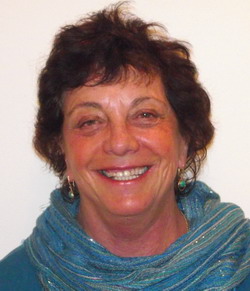
From time to time Doreen will share happenings, experiences, thoughts and ideas through this column.
Go to Doreen and Eitan's Home Page
Column 71 - Jewich New Year 5786
Column 70 - A reply to my cookbook
Column 69 - On my Pesach message.
Column 68 - Pesach 5785/2025
Column 67 - Memories of Bobbe Mary
Column 66 - October 2024 - An Emotional trip
Column 65 - November 2023 - Abducted Hearts
Column 64 - October 2023 - Hostage Square
Column 63 - October 2023 - Musings on the War
Column 62 - October 2023 - The War
Column 61 - October 2023 - Revisiting Riga
Column 60 - May 2023 - A visit to Del' Ara Pacis in Rome.
Column 59 - March 2023 - A visit to the Tel Aviv Levinsky Market
Column 58 - 50th Yahrzeit of Maurice Glazer
Column 57 - Batmitzvah Ceremonies
Column 55 - Tirza and Befrienders
Column 54 - Rockets and Unrest (May 2021)
Column 50 - On burial in Israel August 2020
Column 49 - 25th Family Reunion July 2020
Column 48 - New Year Letter September 2019
Column 47 - A Visit to Jerusalem
Column 46 - Avram Bortenstein and children rescued after the Shoah.
Column 45 - Hebron with Breaking the Silence
Column 44 - Breast Cancer
Column 41 - Impressions of our cruise to Iceland (August 2017)
Column 40 - A short visit to Vienna (July 2017)
Column 39 - Donkey Milk
Column 38 - Our trip to Portugal
Column 34 - Our visit to Moscow
Column 33 - May 2016 A visit to Jenin
Column 28 - (September 2015) - Doreen's Shana Tova Letter
Column 27 - (July 2015) - A visit to the North Norway Islands
Column 26 - (May 2015) - Stuffed Camel
Column 24 - (Nov/Dec. 2014) Meeting up again with the Ogdens
Column 23 - Dalia Lamdani and the ostrich egg brunch
Column 22 (July 2014) - My thoughts on Operation Protective Edge
Column 21 (June 2014) - Doreen's 70th
Column 19 (April 2014) - A Visit to Vietnam
Column 18 (March 2014) - A dive in the shipwreck "Yongala"
Column 17 (October 2013) - some sites, family and friends in Johannesburg
Column 16 (September 2013) - Some musings on Sukkot.
Column 14 (July 2013) : A yachting trip to Corsic
Column 13 (June 2013): Other things to do in London
Column 12 (May 2013) - A few days in Devon
Column 11 (May 2013) Keeping in touch via recipes
Column 10 (March/pril 2013) Visits to Australia and Myanmar
Column 9 (March 2013 -A visit to Herodion.)
Column 8 (January 2013 A trip to the Golan)
Column 7 (October 2012 in Townsville, Australia)
Column 6 (August 2012 - on volunteering) Column 4 (late May 2012 in USA)
Column 3 (late April 2012)
Column 2 (late March 2012)
Column 1 (March 2012 - Reminiscing , places and people
Column 72: Doreen's
Impressions of Trip to South Africa and Azamara Cruise
Column 71: JEWISH NEW
YEAR 5786
As the Jewish
New Year
approaches, the feeling is very different from years past. No looking
back with
satisfaction despite our achievements and that of our family. It is
with a
definite sense of foreboding that we shall mark Rosh Hashanah, Yom
Kippur,
Sukkot and that horrible date, 7 October.
How can we
celebrate when
48 hostages are still in Gaza, hopefully 20 of them still alive; when
we read
of more and more soldiers killed in a fruitless fight for victory over
Hamas? When
the daily count of Palestinians killed or dying of hunger is endless.
The only
victory is Netanyahu’s who maintains his coalition alive at all costs,
and thus
keeping him from facing trials as he stubbornly refuses to accept
responsibility for corruption and the gross failure for the never
ending war
being fought against the wishes of the majority of Israelis and against
the
failure to bring the hostages back.
I was always
so proud of
the Jewish ethic of פדיון שבויים - - the
redemption
of captives throughout the ages. We are now faced with a government
that thinks
of the hostages as a burden, a pawn to be played in its endless war of
messianism, extending the borders of Israel, and false hopes of victory.
It is with
deep sadness
that we see that democracy around the world has failed. More and more
countries
are becoming autocratic. We fear for our children and grandchildren –
what with
climate change and a different Israel, life will be very difficult.
How
proud I have always been to be part of a
long chain of Jews, going back millennia and not only surviving but
flourishing
in all walks of life.
Anti-Semitism
has reared
its ugly head and Jews around the world no longer feel safe. People are
scared
to say they are Jewish.
The only
thing we ordinary
citizens can do is demonstrate. But the recurring thought is: “What
effect do
the demonstrations have?” The answer is if there were no
demonstrations, the government
would have a completely free hand to implement their messianic, racist
and
fascist dreams. We demonstrate, so that the government knows we will
not
desist. Even dictatorships have elections and we must not give up the
hope of
free elections to return Israel to the country we loved: a democracy
where
different views could be expressed, even if not accepted.
I have held
for a long
time that there is apartheid in the West Bank, where there are
different laws
for Jews and for Palestinians and a lack of laws for a growing group of
settlers and youth top hills. Today I
have come to the realization that in Israel proper we have apartheid.
There is
one law for haredim; another law for religious, traditional and secular
Jewish citizens;
and unequal enforcement for other ethnic groups.
Hope and
optimism are hard
to come by in these dark days. But if we abandon hope and despair of
the
changes in this country… what do we have left?
So far we have handed out
some 80 copies and a number of digital copies of my cookbook, Memories for the
Future. Many people have enjoyed the pictures, stories and
recipe
ideas.
But today (July 26,2025) was special because I received a
Whatsapp from Caryn Sangupta, the
daughter of Eitan’s late cousin Viv Klaff (see Goldberg tree) and his wife, my
dear friend,
Frankie.
Caryn made the Watermelon Gazpacho as well as The
Ultimate
Burger, using quinoa and GF panko for a friend with celiac. This was a
most
pleasant surprise, coming from someone who was not a contributor to the
book.
Thank you Caryn!
After sending my Pesach Message (see
below) I was asked by an overseas friend to explain why I had
written
what I had. This is my reply:
Firstly, I am
a secular Jew but hold tradition dear. Secondly I
don't believe that we were enslaved in Egypt – there is certainly
no
historical evidence.
That the people who wrote the bible text chose to center our peoplehood in slavery is unique and places a special burden on us. Every Friday night when reading the Kiddush we must remember leaving Egypt (breaking the bonds of slavery and leaving as free people). Because of slavery, where rest from work was never given, we are obliged to keep the shabbat as a day of rest. - for our family, household and even animals. Slaves were to be freed after 50 years. To me it is the essence of the Haggadah of Pesach..
The laws in the Torah give structure and set boundaries for a people who possibly were enslaved as thus had no rules except for the rules of their slave owners. They are rules on how to order society and settle disputes. Perhaps that is why they chose to set our background in slavery. The Torah wasn't the only code of law in ancient times - Hammurabi (google the others),- so the need for order and regulation in society was recognized. Today we see the flouting of codes of law, to our detriment of society's moral integrity.
For me, if I
were a slave in the past (myth or reality), I would
not enslave another person, whether literally, financially or
politically. We
must not be the masters over other people, and this shapes my
condemnation of
our ongoing rule over the West Bank and the terrible revengeful war
against the
Gazans, which today is politically motivated to keep Netanyahu in power
and
keep his government safe and him away from his dreaded trial.
In the Friday night kiddush it says that God has chosen us and blessed us above all peoples. Our family accepts that we have been chosen (to be a light unto the world; that is our special burden) but we add that we were blessed together with all other peoples, not above others. We are no better than others. The insistence that Israel's army is the most moral in the world is no longer valid. We are no longer fighting an existential war, but a war fueled by politics and the mass imaginings of messianic Jews who are racists and fascists.
That Israel's
government choses war over the release of
hostages, living and dead, is totally unacceptable. Pidiyon
shvuim -
release of hostages - has been a moral duty of Jews for centuries and
most
Israelis demand the release of the remaining hostages, even at the
price of
halting the war. The government does not listen and does not care, A
terrible
shame and unforgivable black mark on our morality.
My husband and I are in our 80's. We enjoyed the best of worlds - after the Holocaust when life was simpler; we saw a changed world of computers, cell phones, choice, a rise in the standard of living, the ability to travel freely and despite the wars in Israel we have led a most wonderful and exciting life. But I fear for what kind of life awaits my children and especially grandchildren - lack of personal freedom and the ability to choose what kind of life they want, faced with autocratic rulers, climate change and incessant wars.
Column 68: PESACH 5785/2025
As we prepare
to celebrate Pesach I find the joy of previous years absent.
Passover, the
Festival of Freedom - for me the miracle of freedom was that, unlike
other
ancient peoples who saw themselves coming from various gods, we Jews
saw our
origins in slavery. It is something so unusual that it places a heavy
burden on
us. We must treat others with respect remembering that once we were
mistreated
and abused. Make no mistake – I do not
think
we were actually slaves in Egypt, but that we are obliged to think of
ourselves
as such is very meaningful.
So how shall we
celebrate freedom this year when we are so acutely aware that there are
59 hostages
in Gaza captivity, 24 thought to be still alive?
How do we
celebrate freedom when we are forced to confront that our freedom has
deprived
others of their freedom, their rights to a happy home and a future of
hope.
I wonder, as we
see democracy being torn asunder in Israel and in many other countries,
is
freedom only achievable under democracy, leaving us with little hope.
Jews need an
open society to thrive and bring their assets to the fore. What will
become of
us in a messianic autocracy, where the
rule of law is the rule of corrupt and unbridled politicians? Where
being a ‘yes
man’ is more important than standing up for what you believe to be
correct and
true.
We have
survived persecutions - The Inquisition, The Black Death, pogroms in
Russia,
the Holocaust and many more. But will we survive loss of democracy in
Israel,
the seeming endless war of revenge and hopeless victory, the
anti-Semitism that
has gripped the world and the horror of Jews around the world at the
changes taking
place in Israeli society
So what can we
celebrate this year? Hopefully a festival where family and friends come
together and retell the story of Pesach as if we were there in Egypt,
bound for
freedom. This year we shall not leave an empty chair for Elijah – he
can wait –
but shall leave an empty chair for the hostages still in the hell of
Gazan
captivity.
Column
67: Memories
of Bobbe Mary
When
I think of my maternal grandmother Bobbe Mary, it is always a warm
memory, but there is very little I remember
about her.
I
always think of her as old, but I know that she was a young firebrand
and as a
young woman in South Africa she would go to political rallies that her
husband
Louis didn’t approve of. To prevent her going he hid her shoes, so she
just went
barefoot!
She
and Louis lived in Doornfontein, a suburb of Johannesburg. Their house
had an
internal courtyard where fruit trees grew. I remember Bobbe's grape
jam,
but I also remember her drinking black tea while sucking a cube of
sugar. She
was an excellent baker and her cinnamon babka was a treat. To break the
fast
after Yom Kippur people who fasted were given soda water and milk to
drink with
a slice of her famous babka.
Eitan
has written about the Nickel
family and cricket. What he didn’t include is what
an achievement it was for Bobbe's son Aaron, a Jewish boy, to be chosen
for provincial
cricket. At half time how embarrassing it was for him when his mother
would
march up to him on the cricket field bearing sandwiches.
When
I was a child at school we had to knit. I was terrible, dropping
stitches and
making sifters with holes in them. The solution was for Bobbe Mary to
knit
whatever I had to present at school.
I
have this intimate memory of Bobbe sitting and knitting while my mother
spent
many hours embroidering a beautiful picture of exotic birds and
flowers. I would
always sit at my mother’s feet. One day
she shouted “|I’ve finished” and threw up her hands. I jumped up, and
stood on
the needle that she had been embroidering with. The needle broke and it
took
over a year and two operations to get the needle out.
Louise
tells me that when we had to go to Yiddisher Folk Schuler we would go
to
Bobbe’s house afterwards.
In
those days when one got married there was a tiered wedding cake and
inside it
were small slices of fruit cake wrapped in cellophane wrap for the
guests. It
was said if you put the cake under your pillow at night you would dream
of the
man you were to marry. There is this wonderful picture of Bobbe asking
for
cakes for all her friends at the old-age home where she lived then.
I
hope that my grandchildren will have more memories of Eitan and I. We
have
tried to be meaningful and active parts of their lives, and the many
Family
Reunions, pictures and hopefully 2 cookbooks will keep the memory of us
alive.
Coming back from visiting Louise in Kfar Saba, I received a call from Road to Recovery asking me to fetch a young boy and his grandfather from the National Insurance Institute and take them to the border crossing Eliyahu. That was so unusual that I repeatedly asked whether to drive them to the West Bank crossing.
It was Ahmed Duwansha. His parents and his younger brother were burnt by Jewish terrorists 8 years ago. He was the only survivor. Half his head was scarred and the hair doesn't grow.
His amazing grandfather Husein had accompanied him.
The despicable actions of the settlers is an eternal shame on us.
November 2023 - Abducted Hearts
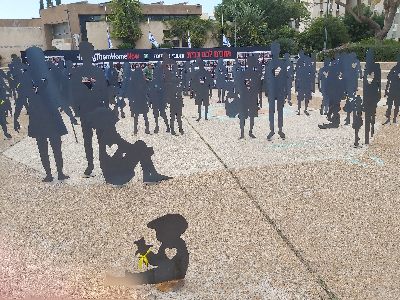
My friend Caroline and I drove south for an hour to Nes Ziona to see the depiction of hostages
at the Cultural Center there.
The
hostages are represented by 242 life-sized figures cut out in unadorned
metal symbolizing the
babies, children, youth and elderly. But what
makes this
exhibit unique is that each figure has an
empty space where the heart
should
be, hence the name of the exhibit “Abducted Hearts.”
The
poster explaining the exhibit talks of the incomprehensible
number of hostages, taken from
homes, a festival and from their daily
lives.
The hole in the heart represents the unbreakable
connection between the
hostages and all of us.
A
massive wall with the now familiar
“kidnapped” posters gives a backdrop to the statues.
The posters
include the
portraits and names of Hadar Goldin and Oron Shaul, two Israeli
soldiers
killed
in the 2014 Gaza War whose bodies have been held by Hamas since then as
well as
a picture
of Avera Mengistu who crossed over to Gaza nearly 10 years
ago and is
still being held captive.
At the
time of writing there is talk of an exchange between 50 kidnapped
civilians held in
Gaza in exchange for a cease-fire. and the release of some Palestinian
women
and children from Israeli jails. And we must ask - what
about the rest of the hostages? Those
needing medical attention, the babies
needing special food, those who
are terrified? What will happen after those with dual nationality are
released
leaving in Hamas
captivity those who are Israeli citizens without the buffer of
another
nationality? Our
hearts are torn by worry and despair for all the hostages.
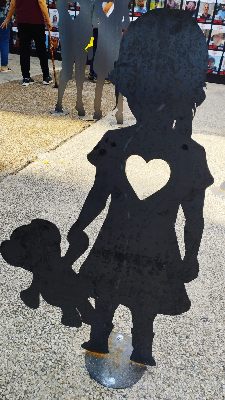
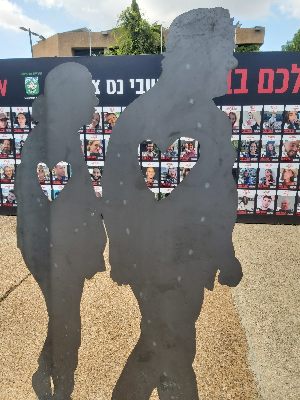
The IDF
has a mission and a promise that they will do everything to
bring back soldiers who are wounded or dead. How much more is the
imperative to
see to the release and return of kidnapped, innocent civilians
October 2023 - Hostage Square
My granddaughter
and I drove to Tel Aviv to Hostage Square in front of the Tel Aviv
Museum.
Although the square is open to a very busy street it was eerily quiet.
As we entered
the square there was a semi-circle of small mirrors on poles around a
supine
face by Kadishman. As you looked into the mirrors, the message of the
installation was clear – it could have been you.
All over there
were pictures of the kidnapped and missing. Dani saw a picture of her
friend,
kidnapped.
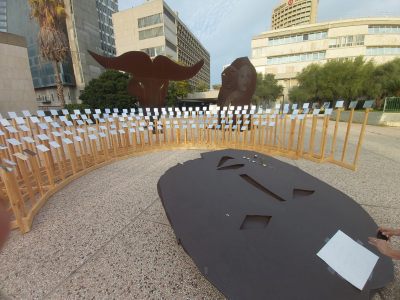
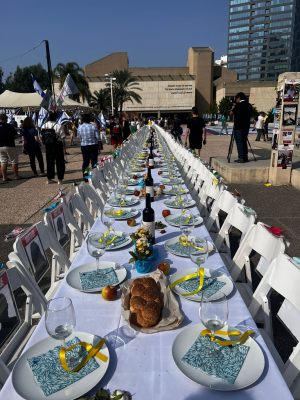
There was a
long table covered by a white tablecloth with place setting, flowers,
wine
and
challah with seats, some of them baby chairs, for 200 people,
symbolizing the
hostages.
Last night on the news the number of missing was downgraded to 30 while the number of
kidnapped upped to 239. And it is unbearable to think of their fate. The army has not managed
to find a single person – they are most probably in kept in tunnels deep underground, and we
fail to even imagine under what circumstances.
There was a long cloth spread on the ground where family and friends had written messages of love, hope and pain. What caught me was a heart torn in two, but the most moving was that by a number of stuffed toys there was a book with the title in Hebrew איפה הסבתא שלי? “Where is my Grandmother?” I think it epitomizes the unfathomable loss of the families and friends.
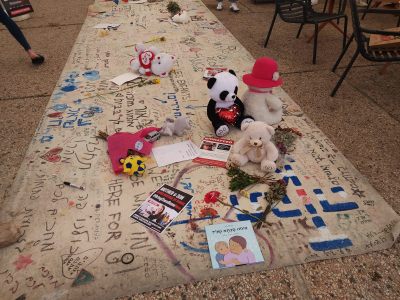
It was a very
sad visit, heartbreaking, heightened by the feeling of helplessness.
October 2023 - Musings on the War
I know that
many do not share my views and most probably will be against what you
will read. But through our emails we have shared many feelings of pain
and
worry about the war and its outcome, and about anti-Semitism
manifesting again
so openly and viciously. Please accept that the following is my truth:
We wait. We
wait in limbo – will the IDF actually invade Gaza? Will the Hamas
really free
hostages? It appears that over half the hostages have dual nationality,
who while
still maintaining citizenship of their former countries are still
Israeli
citizens. And we fear for them.
I personally
believe we must do everything in order to return the hostages, either
hopefully
alive, or those who have been murdered in Gaza.
Do you worry
about the damage to Gaza? Had Israel not developed the Iron Dome, in
which a
friend of ours who was involved thought couldn’t be done, half of
Israel would
look like the ruins in Gaza. Destroy Hamas? A pipe dream, because
should it be
achieved an even more militant group, like ISIS, would emerge.
I’m not a
historian but I am aware that empires and colonialist powers,
invincible for
many decades have simply disappeared – the Babylonian Empire (that
destroyed
the First Temple), the Roman Empire (that destroyed the second Temple)
each lasted
for more than a thousand years, The British Empire continued for 300
years, the
Russian Empire lasted for nearly two hundred years, the Soviet Union a
mere 70
years, the Apartheid regime in South Africa collapsed after just over
40 years.
To me the lesson learnt is that you cannot subjugate or oppress another
people
forever. One has to talk and negotiate even with your bitterest enemies.
The inhuman
horrors perpetuated by the Hamas cannot be forgiven and should not be
condoned
or understood by anyone. But together with that we should acknowledge
that
many, many innocent Gazan people have suffered in attacks by Israel as
well as
those committed by the Hamas against their own people.
The
volunteering efforts of ordinary Israelis are amazing: while a few
weeks ago
the country was divided now the whole nation has opened up their
hearts, and
their pockets to help those displaced from Gaza and the north. You can
see how our
cousin, Yaakov Bortenstein helped give 500
Golani
soldiers a “Yom Kef.”
Our
youngest grandchild constantly bakes cookies for soldiers. Our son-in
law Aviv
and his daughter Dani helped pick peppers because of the lack of Thai
workers.
Our son Moran has been intimately involved with helping Thai workers
who
managed to escape the Hamas onslaught. And we have had the privilege of
hosting
a lone soldier, a young woman from Cleveland. And that is just our
family. But
even going to work while so distressed and carrying on a normal life is
an act
of faith. So many ad hoc volunteering
groups are helping with ceramic vests, food, clothing and comfort.
There are heartening attempts
to foil
Israeli-Arab violence within Israel and a number of groups work
together. To
mention just a few: Amongst them are Standing Together Combatants
for Peace Israel/Palestine ; Parents
Circle Families Forum where Israeli and Palestinian bereaved families
share
their loss and grief; Road to Recovery, of which I am a volunteer, who
drive
Palestinians, mostly children from the checkpoints between Israel and
the
Palestinian Authority to hospitals in Israel for urgent and ongoing
medical
treatment Most pharmacies in Israel
today are overwhelming run by Arab
citizens and they work ceaselessly for all citizens. Arab bus drivers
face
hostility from Jews who see every Arab as a Hamas supporter. How
quickly we
have forgotten how Jews were treated. No that is not quite true. We see
anti-Semitism,
not anti-Israel sentiments rearing its ugly head over much of the world.
We have lost the feeling
that Israel is invincible,
our feeling that Israel is a truly safe haven for Jews. We fear for the
outcome
– there will be no winners in this conflict.
May the price
for peace not be too devastating.
October 2023 - The War
We
are still among the fortunate ones whose immediate circle of family and
friends
are safe. .We have two grandsons in the army (sons of Aviv and
Moran) but
they are not combat soldiers. Unfortunately we all know of soldiers
killed,
people murdered or taken hostage. Nothing so tragic has ever happened
to the
State of Israel. Events were acerbated by a messianic, racist,
right-wing
government, more concerned with the settlers, legal and illegal in
the West
Bank than citizens in Israel's south. And bent on doing everything
possible to
keep the prime minister from facing trial and imprisonment. But I think even if the government was
functioning well, no-one could foresee the magnitude and way the Hamas
attacked.
Millions spent on building underground walls to prevent tunnels into
Israel
were of no avail because the terrorist just broke through the border
fence and
climbed over the wall. They were so well prepared - they knew the
minutest
details of the kibbutzim where they were to slaughter innocent
civilians and
young people at a music festival. When we see the pictures of the
hostages, especially the infants, young children and elderly abducted
from
their homes and all those smiling faces of the young people at a music
festival, the heart breaks.
So when you ask anyone 'How are you?' the answer is 'fine." But we are not fine. The whole country is suffering from Traumatic Stress Syndrome. We are all grieving for the dead, fearful for the fate of the hostages and worried about the next stage of the war. Israel will be damned for entering Gaza and causing the killing of hostages; and Israel will be damned for not entering Gaza, enabling the killing of hostages and the strengthening of Hamas. A horrible dilemma.
And our prime minister is still more concerned about
exonerating
himself at the commission of enquiry at the end of the war than
anything
else.
This is our home that we love so much and we have taken part in the weekly demonstrations fighting the undemocratic direction that the government was taking. The country was so divided. Now, together we all mourn the loss of Israel as we once knew it and grieve for the dead and fear for the fate of the hostages.
We personally are too old to take part in the heart-warming volunteering efforts except to donate money and open our homes to anyone in need of shelter or respite. We are proud of our family who are doing everything they can to help, They are packing food parcels, our grandchildren engaging the children from communities bordering Gaza and hosted in their area, baking biscuits for soldiers, picking vegetables to replace the poor Thai workers, killed, taken hostage or just unable to work because of the trauma. All have hosted families from the south and continue to help those unfortunate people who had to immediately leave their homes.
Although Eitan had resigned
from the EBL
and had handed over the responsibility of organizing seminars for
tournament
directors to others, he was called upon to help the following year. We had
visited Riga twice before, but this time I had a specific
goal in mind. I
wanted more information about the burning of Jews in synagogues in
Riga. At the
Riga Ghetto and Holocaust Museum I met Yuliya Tereshchenko the
Executive
Director of the museum. She encouraged me to send her any information
we had
about my grandmother Nessie Glezer and she would see if she could find
additional information.
In anticipation of the Nazi
invasion in
July 1941, Latvians sympathizers went on a rampage killing Jews even
before the
Wehrmacht arrived.
Yuliya told me that Viktor
Arajs, a Latvian
collaborator was the leader of the Arajs Kommando in Riga. He was also
complicit
in the massacre of Jews in Liepaja, in western Latvia. Arajs was also
sent to
Belarus where Jews were captured for forced labour and later died.

The
last
sighting of my grandmother Nessie was in Olshan/Golshany Belarus, where
someone
reported
she had been burned to death in a synagogue.
As I had
previously
written no Jews were burned in synagogues in Olshan, but the report is
so
dramatic
that it must be true and leads us to believe she was burned
alive in the
Choral Synagogue.
All the synagogues, some 19 of them, were burned, some with people inside. Synagogues and Houses of Prayer
throughout Latvia were similarly destroyed then. The only one that was not burned was the synagogue on
Peitav Street in the Old City of Riga. The priest said the synagogue was surrounded by wooden houses that
would have burned down too.
An advertisement was printed in
the Latvian
newspaper calling on all patriotic Latvians to enroll and take part in
the
cleansing of the country from undesirable elements (Jews especially but
also
Roma). No punitive measures were taken by the Nazis against those men
who
refused to join. It was these willing Latvian collaborators, not the
Nazis, who
instigated the killing of the Jews.
At the end of 1941 in a two-day
rampage
some 25,000 Jews from the Riga ghetto were forced to walk to the
Rumbula Forest
by Einsatzgruppen and the Arajs Kommando. There Soviet prisoners were
forced to dig pits
for the shooting of the Jew, after they removed their clothing and
valuables. A
survivor said the victims were layered one on top of the other murder
victims and
packed orderly like sardines. It was the second largest massacre after
Babi
Yar.
It was an emotionally exhausting tour, but most informative. The present museum has a large outdoor display and scattered rooms with exhibits. My guide told me that a new encompassing museum will soon replace this one. I walked to the Peitav synagogue and said kadish for my family members who died in the Holocaust. Even though I was the only one in the synagogue, it gave me comfort to remember them in a traditional way.
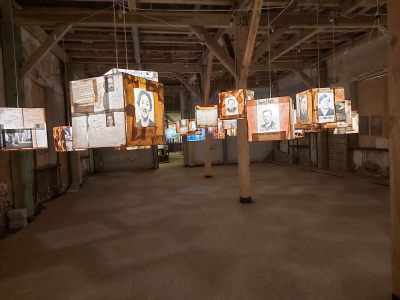
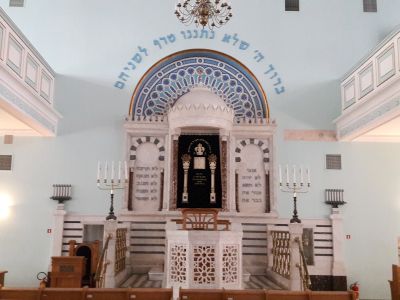
Most of the streets in Riga are
cobbled
whichhad me hobbling back to the hotel on aching feet. A visit to the
Central Market
lightened up the day.
In the evening we took a taxi to the Kollonade restaurant. We felt the
taxi was taking a long time to get to the destination. He stopped. We
looked
around and asked where was the restaurant. He gestured in the direction
of
MacDonald’s. After some time a man helped us and pointed to the
restaurant
across the road, somewhat hidden by a large column. Good choice;
expecting
Latvian food we were surprised by a modern kitchen and delicious food.
May 2023 - A visit to Dell' Ara Pacis in Rome.
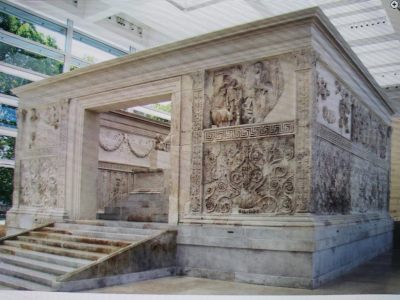
When we were in Rome before our Tuscany holiday we
decided to visit Del' Ara Pacis. The first time
we went, after walking a long way, we found it closed.
Undeterred Limor, Aviv and I returned the next day. It was well worth
the
effort.
Built in 13 BCE, and commissioned by the Senate, it was to honour
Augustus
Caesar’s victory over Gaul and Spain and the establishment of Pax
Romana. It
celebrated Rome’s greatest territorial expanse and inaugurated a period
of
relative peace and development that lasted for about 200 years. It was
essentially
an open air altar for sacrifices for Roman State religion led by
Augustus.
It is a large
cube richly decorated with friezes while inside there are steps leading
to the
altar. But with time the unstable ground near the Tiber River caused
this
massive monument to sink into the ground and it was forgotten for
centuries,
until the earth was frozen and the remains that hadn’t been carted off
we
recovered. Interestingly, it was Benito Mussolini who ordered this
massive
project in 1938 to commemorate 2000 years since Augustus’ birth.
Today’s glass
restoration was designed by Richard Meier.
March 2023 - A visit to the Tel Aviv Levinsky Market
Eitan and I have recently
returned from a
visit to London where we enjoyed a visit to the Borough Market.
But this last Friday Vered,
before flying
to the States later that day, invited me to join her for lunch at the
Levinsky
Market in Tel Aviv. What a delight! Only 6 streets long extending from
Rehov
HaAliyah to HaMashbir Street, it is an oasis of food of all kinds.
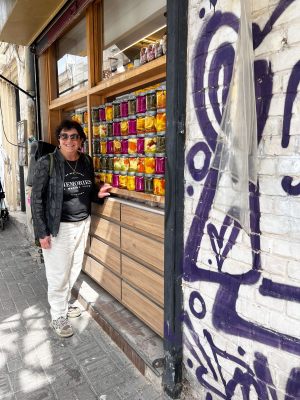
Levinsky market used to be
known for its
spice shops originating with immigrants from the Balkans.
Today there are still
many traditional spice shops, but the store of
Pereg Spices, sold in all supermarkets
heralds the gentrification of the
area.
The restaurants are numerous,
two of them vying
for the best burekas in the market. There was a very long line at the
shop
selling at least 10 different kinds of
kubeh, a whole shop devoted to different kinds of halvah, others
selling dried
fruits and nuts, or pickles, herring, wine and cheese. Noticeably,
there were
no fruit and vegetables stores, but a quaint hole in the wall, Gazoz,
sold
updated version of gazoz with fruit and herbs, a nod to soda drinks
from
decades past.
Vered took me to Saluf and
Sons, a Yemenite
restaurant for lunch, where we enjoyed Kabaneh, a light bread with dips
and a
delicious Jahnun wrap with egg and pureed tomato. For dessert we shared
a
malabi with rose water topping. Vered doesn’t like the topping, so we
shared –
I ate the top half and she the bottom half.
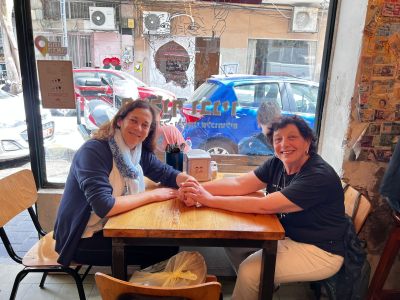 But perhaps the best part of the
day was enjoying
quality time with my daughter!
But perhaps the best part of the
day was enjoying
quality time with my daughter!
January 2023 - 50th Yahrtzeit of my father, Maurice
It is Moran’s birthday at the end of
the month. He was born exactly two weeks after my Dad died on 16th January 1973 at Ichilov Hospital
Tel Aviv. That was 50
years ago
My father’s uncle Joe (Yahne) Glasser
immigrated to South Africa, under what circumstance I do not know. But
when he
had amassed enough money he sent it to my father, the oldest of three
brothers,
to leave Vilna and come to South Africa. I often wonder how parents
could say
goodbye to their child, knowing they may never see him again. What
courage that
demands.
My father was tall and slim, a good
looking man. He wore thick dark green glasses. He said his eyesight was
ruined
from his first job at Peel’s Cold Storage in Johannesburg where he sat
in
the
basement and had to check the eggs against a candle to make sure there
were no
embryos inside. My mother Gertie relates that on their first date he
took her
to a restaurant and she was very impressed how he knew the best foods –
not
realizing it was because he worked in a grocery store.
My father loved watches and ties. We had heard
that if anyone admired his watch he would take it off and give it to
the
person. My sister Louise actually met such a man in Raanana.
After they married they moved to
Springs Transvaal where I was born. They had a fish shop. My mother
submitted a
bid to supply the nearby British army camp with eggs at a lower price
than the
then current market price. My father was in a panic, but on the day
they had
their first delivery the price of eggs dropped and they did well.
My
sister Louise used to ‘help’, putting the eggs in a carton. My mother
said she
didn’t care how many she broke as long as it kept her quiet.
When my father had saved enough money
he sent for his brother Mike. Together they never got enough money
together to
bring out Avram the youngest brother or their parents. My second cousin
Yaffa
recently told me how my Dad went to relatives in Johannesburg and
begged them
for money. They couldn’t or wouldn’t give him money. His father Mottel
and
his brother Avram were rounded up and murdered at Ponar after which his
mother
Nessie ran
away and was eventually burnt in a synagogue, we presume in Riga. Many
other
family members were murdered during the Holocaust. Cousin Florence told
me that
my father would visit her ma when he came on business to America and
talk and
cry. We never saw this; all he ever said was that his family was burnt
to death
in a synagogue.
Uncle Joe offered my father a share
in a clothing factory he had bought in Johannesburg, neglecting to tell
my
father that the factory was bankrupt. He and my mother undid a shirt to
see how
it was made. She worked in the factory in the beginning until they
established
themselves. He made a great success of the business, under the
name of
Star Shirt and Clothing Factory, with factories in Rhodesia, Windhoek,
Hammarsdale
and
eventually moving them to Durban. His brother Mike and other relatives
and my
mother’s brothers all worked for my dad at some stage. He was very well
considered in the clothing business.
Yahne Glasser was very much into the
revival of Yiddish and he and my father donated a van to pick up the
children
and take them to Folk shul. I hated going and once even jumped into a
bed of
roses to prevent having to go in the van. I still remember the first
pages of
the book, with pictures that we had to learn and the play where I was a
green
tree.
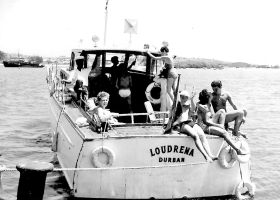
When he moved his business to Durban
he decided to build a motor launch, called Loudrena after my sister
Louise and
I. Many of my friends still talk about our going out on the
Loudrena,
something very special in those days.
My mother Gertie and my Dad didn’t
have a good marriage and my mother divorced him when I was pregnant
with
Aviv. My mother then came to live in Israel.
My father visited Israel often,
always coming laden with presents like Father Christmas. When I was
pregnant
with Moran he took ill, I think with diverticulosis for which he
underwent an
operation and never recovered. He had been a heavy smoker for most of
his life
and it was his lungs that gave in. Although I was full term I used to
visit my
Dad every day in hospital. One evening the weather was terrible and my
husband
Eitan said he would take me to the hospital the following day.
Significantly,
my father died the night I didn’t come.
Although I was an adult when my
father died I felt like an orphan. He was like an umbrella, shielding
me from
harm. Initially he did not approve of Eitan as a husband and I left my
parent’s
home to continue our relationship. My Dad later came to have an
excellent
relationship with my husband Eitan and treated him with respect and
affection, often
taking him aside for serious conversations.
See also This Week's Picture 23
January 2023
What
a surprise and delight it
was. Twenty young girls from the four neighborhoods in Netanya were
bussed to
the Neot Ganim Community Center where the garden was decorated with
festive
balloons and seating for the participants and their mothers. The girls
began by
writing greetings in each others special notebooks while the mothers
prepared
decorative hearts for each daughter. This was followed by a workshop of
making
beautiful candle holders from recycled coffee capsules – a lesson in
crafts and
recycling!
Miriam
Fierberg-Ikar, the
mayor of Netanya arrived and greeted the girls, their mothers and the
ESRA
family. Nina Zuch of ESRA opened the festivities with a welcoming
speech, after which
the emceeing was handed over to Fasika, one of the ESRA students in
the
project. However, it was the words spoken by the 5 student
mentors to
“their children” that were truly impressive.
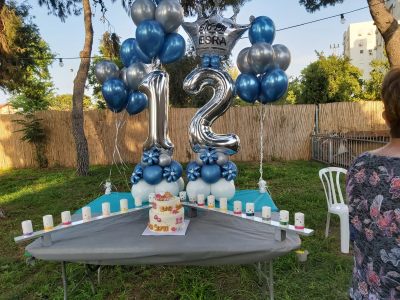
The
“cake” table was decorated
with balloons and 20 candles around a festive cake. Each mentor called
her
group of young girls to the table and addressed them saying it was the
end of
the project for them, but not the end of their access to her. The girls
had
spent several years in the project (from 3rd grade) as
they
grew emotionally, learnt life skills and began to understand the
importance of
togetherness and the power of involvement, working within a community.
Perhaps
the most meaningful words were when each mentor expressed how fond she
was of
‘her’ girls and what a tremendous learning experience it had been for
her as
well.
After
a meal of delicious
pizza, the evening ended with the girls dancing together with their
mothers
under the exuberant guidance of the students and backing by DJ Itzchak
Tamano.
8th -14th May 2022 - Diary of a Corona Victim
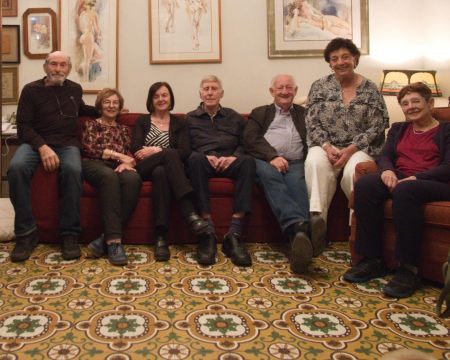
On Saturday May 7th we enjoyed the company of ex-schoolmates Maureen (Koningsfest) Fain and Helene (Goldberg) Levitan and husband Selwyn first at our home and then at the Zichron Yaakov pedestrian mall. (Picture).
On Sunday evening for dinner at Maureen’s house in Jerusalem we were joined by another ex-schoolmate Ilana (Rubinstein) Dubb and husband Leo and enjoyed food, memories, friendship and conversation.
l-r: Selwyn Levitan, Maureen Fain, Ilana and Leo Dubb, Me and Doreen, Helene Levitan
We returned home to Netanya in good spirits but that night we hardly slept as both Eitan or I were waking each other up with coughing.
Day 1:
Monday morning I decided I really had to go to the gym and join my
water aerobics class. Standing in the kitchen and looking at the clock
I told
myself "You don't feel well. Don’t be stupid, you’re just lazy;
it’s
just a long
time since you last exercised. But you really don’t feel well. Excuses.
Just put
on a swim suit and go".
Just
before leaving for the gym Eitan woke up and said he didn’t
feel well and wanted to do a corona test. He tested positive for Corona
on the home kit. I
was negative. On the advice of son Moran
we both made appointments for a PCR test in the afternoon.
By that
time we both were still coughing and by now we had headaches
and aching muscles. Driving the 20 minutes to the drive-through testing
site I
remembered when Eitan and I contracted ciguatera in the Bahamas – that
same
weakness in the muscles and I was pleased it wasn’t far to drive.
A super
dinner party planned for Saturday evening had to be
cancelled as well as the 3 kilo lavrak (sea bass) fish I had
ordered and
planned to bake in salt.
Day 3
Wednesday: Coughing less but with a sore throat and I had a lot of
phlegm. To our surprise Kupat Holim Clalit, our health provider called
to say
that they were delivering, at no cost, pills for us to take, which
don’t help
with the corona but help prevent aftereffects. Vered was relieved to
hear this
as her friend who heads the corona department at Rambam had urged us to
take
the pills by the third day at the latest.
Day 4: We
were feeling much better. No headache.
Coughing less. If I sat still, I felt fine. I could inform well-wishers
that we
were still positive – not only in the test for corona but also mindset.
Any
physical activity, however, made me understand what the word
‘lassitude’ means.
Day 6:
Disappointing, still
positive but less so, according to the thickness of the lines on the
home
testing units. I read that the prevalent strain in Israel is now BA2
and that
there is a rise in the R index. I’m afraid we unwittingly may have
personally
caused this rise in Israel’s numbers 😒.
But who knew?
Let's hope for good news tomorrow - Day 7.
Victims
we are not but persons who have had a bout but not a knockout with the
pandemic.
October
2021 - Tirza and Befrienders
This particular course was organized to reach out to lonely people, at this time when so many were isolated and alone. We were required to call our Befriendees on a regular basis.
I was asked to contact Tirza Naor, a 97 year old Holocaust survivor who lives at Ganei Omer. . She wanted to talk to someone who could hold interesting conversations. Our weekly
talks were not only interesting, but developed a meaningful bond between us. I have managed to meet with her a number of times.
We were delighted when a picture, taken on my first visit to her appeared in the ESRA calendar. We took another picture when I presented her with a copy of the 2021-2022 Calender.
The picture, and pictures of the calender page, can be seen here.
May 2021 - Rockets and Unrest
In
May 2021 we were breathing a sigh of relief that Covid was no
longer a serious threat in Israel and the chances of a change in
government
seemed good. The worst seemed over and things could only improve.
Then the confrontation with
Gaza exploded into Operation Guardians of the Wall with Israeli cities
under
constant bombardment and the air force relentlessly attacking Gaza.
Rockets
rained incessantly on Ashkelon and Ashdod with rockets
also aimed at central Israel, including Jerusalem, Tel Aviv and Ben
Gurion
airport, even reaching us in Netanya. The amount and range of fire
greatly
surprised most Israelis. The huge number of rockets released meant that
Iron
Dome’s efficiency went from 96% to 90% and buildings were damaged and
people
were killed.
Then
to our horror violent confrontations, with both sides to
blame, broke out between Arabs and Jews in mixed cities with the army
unable to
contain the damage against people and property. Arabs and Bedouin in
Israel
exploded in anger and frustration with terrible sights of violence
especially
in cities with a mixed Jewish-Arab population. Roads became unsafe
because of stoning
by Bedouin and Arabs on cars on the main motorways.
The
Gaza confrontation will eventually subside but we are very
concerned about how to repair relations and ameliorate the position of
the
Arabs in Israel.
How
things have changed so dramatically: At the beginning of April,
I joined a tour of Bedouin villages south of Beersheva by Dr. Michal
Oren as
part of her series of lectures “To whom does the land belong.” We were
well
received by local Bedouin in recognized and unrecognized villages who
explained
the difficulties they face before government offices, mostly deaf to
their
concerns and their wanting to keep their traditional way of life. The
government would like all Bedouin to move to Rahat or another Bedouin
village.
Just
a week ago I joined another tour with Michal Oren to
Ajami,
a mixed neighborhood between Jaffa and Bat Yam. We walked around quite
safely
as the story of Ajami unfolded. In 1948 Arabs in Jaffa were
concentrated into
the Ajami quarter and told to take possession of a house that had
belonged to
an Arab who had left/fled. They had to
pay rental to Amidar and were not allowed to make any changes to the
house they
received. In addition the houses were theirs for three generations. The
fourth
generation had to move out (to Ramle/Lod) unless they could get the
money to
buy the house. There are rich Arabs, but many are poor who face many
difficulties, unable to get the money to buy the houses to which they
were
brought. In addition there is a move to Judaize Jaffa and increasing
gentrification causing property prices to increase greatly.
We
had planned to visit our son in Sde Boqer over the weekend but
were warned that the roads aren’t safe – cars have been stoned on toll
Road 6
and also as they passed Bedouin villages on the way south.
And
today (Sat 15/5) Nakba Day there were riots in Kfar Cana an Arab town
in Wadi Ara
that I have visited a number of times when attending meetings there of Road to
Recovery.
An unexpected result of this tension and despair is the lethargy that has overcome me, with the slightest household task burdensome. While slowly hanging up the washing, I suddenly thought of the incredible stress refugees have to face on physical and emotional levels. It’s overwhelming.
But the picture below with our son Moran taking part in a Jewish-Beduin solidarity demonstration at Mashabei Sade not far from his home at Sde Boqer gives up hope.
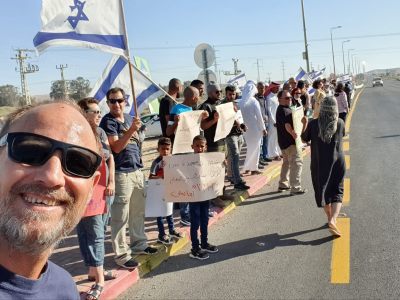

I joined a tour of Ajami Yaffo conducted by Dr Michal Oren.
I appreciate her willingness to talk about issues that others prefer to skirt.
She sees Ajami as the microcosm of the Israeli-Arab conflict and helped us
understand the frustration and anger of the Arabs in Ajami against gentrification.
Column 52 - The Proficient Pet Poop Picker Person
Appalled by the amount of
dog poop on our pavements I decided to go on a one-woman crusade and
make at
least our street crap free.
I started by picking up the dog poop
that the dog owners hadn’t. But I figured they would think the
municipality
workers were continuing to literally do the dirty work for them, and
they
wouldn’t care.
So each time I picked up the poop I
left a little yellow sign with the date and message referring to myself
as הסבתא הזקנה the old
grandmother
picking up the poop. After a few weeks of picking up crap, our street
is
noticeably cleaner, with only occasional blobs of poop (which I
continue to
pick up). As I leave our building I look right and left. Pavement
clean! What a
pleasure it is now to walk in our street.
A few nights ago at a meeting of
people from the buildings in our area to discuss keeping the area clean
I
introduced myself as the poop-picking grandmother. One of the women
looked at
me and exclaimed: So you’re the grandmother! You’re famous. You’re on
Facebook.”
Well, I don’t go into Facebook so I
can’t relish my fame. But I hope it may change the habits of the people
who
live around here.
Column 51 - Rosh Hashanah 5781
Dear Family and friends,
The start of the Jewish New Year
5781 is a sobering one. We won’t be celebrating with family as Israel
will be
under lockdown because of the unprecedented rise in new cases of Covid
19. Few
believe that this lockdown, full of holes, will bring down the rate of
infection; instead it is intended to curb the increasing vocal protests
against
Netanyahu and is a sop to the ultra religious, forcing the whole
country to
suffer a lockdown
But as we look back, we have had
some good times this past year and cherish these memories in the hope
that the
coming year will bring relief from the pandemic, the economic crisis –
and also
from the unbelievably long heat wave we are experiencing.
In Israel as the prime minister does
everything in his power to evade trial on multiple corruption cases, he
gains
plaudits for the signing of “peace” normalization treaties with the UAE
and
Bahrain. This is definitely an important juncture, but many believe it
was a
photo op intended to boost the standing of both Trump and Netanyahu. After all Israel has had economic ties with
these and other Arab states for years, but it is peace with the
Palestinians
that we need to forge.
We hope the lock down will reduce
the number of corona cases and not just increase the economic woes of a
vast
proportion of the population.
We will still have many hurdles in
the coming year, but extend to you the hope that the coming year will
be better.
ארץ אוכלת את יושביה (במדבר יג:לב)
האומנם?
This
quotation is from Numbers 13:33. When the 12 spies sent by Moses to
scout the promised land returned from
Canaan, 10 of the spies reported that “the land we explored devours
those living in it…” It is often quoted to
describe how hard it is
to live here in Israel. We are a
nation divided
by narrow tribal interests with no national consensus with a crook and
liar
leading
the country who is no longer believed by the masses, while Covid 19
continues
to rear its ugly head. And that’s before we talk about economic
hardships, the
high cost of living, the huge number of poor, a country that is sliding
towards
apartheid, because it is not a dirty word for a large portion of the
people. A
country where the word סמוך (rely) has taken on new
meaning, meaning
rely on the messiah to fix all our ills.
So
in this country one would believe that being buried here in Israel was
also an
easy matter – after all, religious Jews have come to
Zion for centuries to
be buried.
Well,
living here is hard, but dying here is even harder.
Although
we no longer live in Hofit, I have always taken comfort from the idea
that when
I die I shall be buried in Hofit among our many friends from the area.
When I
enquired a
number of years ago how to reserve a burial place in the local cemetery
I was
assured that there was no problem. When I said that I wanted a two-tier
grave
for Eitan and I they said they don’t do that. A few weeks ago I phoned
the Hofit
local council and was horrified that they have changed the conditions
and
although we had a house in Hofit for 40 years we no longer qualify to
be buried
there.
I
had visited the civilian burial ground in Netanya on my bicycle a long
time ago
and we thought that would be an acceptable solution. I drove over there
three weeks ago and
saw many
plots with a stone “reserved” on it. I was told there were still a few
empty
plots, but they were now burying three people in one plot. Okay – hope
we
get along
with the third person. Since we were about to go overseas sailing, I
waited two weeks
and contacted them immediately on our return. NO PLACE!!!
So where are we to be buried now?
Eitan suggested cremation. But since I suffer
so from the heat I couldn't bear the thought of my body consumed by
fire.
It
seems this country devours only living people and refuses to gather the
dead
into its arms.
Column 49 - 25th FAMILY REUNION - July 2020
With
lockdown from the Corona crisis easing we decided it was time
for another Family Reunion. Ideas of flying to Summer Wine, a resort on
the
island of Corfu, run by friends of ours from way back, were dashed when
we realized
that flying overseas was a no starter. Renting a villa in Israel for 16
people
was outrageously expensive so we decided to spread the reunion between
the
house of the Rons in Herzliya and our apartment in Netanya. Eitan and I spent days organizing a fun
weekend, full of activities that would occupy us and keep us from
mixing with
others, because the number of corona victims had spiked alarmingly.

We planned,
shopped and cooked and were ready for the first
arrivals early Friday morning, Aviv and
family.
At lunch time Moran and family arrived as did Vered and when the pizza
arrived we all tucked in, just happy to be together.
Eitan handed out the masks
we had prepared for our Reunion and everyone was amused that we hadn’t
printed
a T-shirt this time.
After lunch we
split up; the four girls and Joanie the dog sat chatting on one bed and
the two
boys on another.
The adults sat and talked and talked in the lounge.

After the afternoon rest period, Moran came out of his room with a
mask on his face.
“Plans have changed,” he told us, with our not understanding
what he meant.
A friend of his who had visited him earlier in the week was
reported corona positive.
Within 15 minutes he and his family had left to
return to Sde Boqer,
and Moran to isolation, alone in his room. We were all in
shock, devastated by the news.
The remaining 11 of us did go out for a delightful dinner at the
Herzliya Marina, sitting out in the open and afterwards to the Rons for
ice
cream and cake. It would have been a perfectly lovely evening, except
that
Moran and family were sorely missed.
We went
home and eventually went to bed, not knowing that we would
be having an unplanned midnight Treasure Hunt.
Eitan took Joanie the dog for her midnight walk and came back to
say
that Joanie had disappeared. After 20 minutes, worried, he went to look
for
her. A few minutes later there was a knock at the door and an unknown
woman
stood there with a smiling Joanie at her feet. Amit who had woken up
looked for
Eitan around the house, but he wasn’t there and also noted that he
hadn’t taken
his cellphone. Panicking she woke up Aviv and Limor who from deep sleep
shot
out of the house and started running, looking for Eitan. The kids and a
tied
Joanie joined in the hunt. After half an hour Limor woke me up and I
joined in.
While standing in the street talking to Aviv, who was by now patrolling
in his
car, Eitan arrived. He had passed the apartment a number of times
expecting to
see Joanie standing by the entrance to the building, and when she
wasn’t there
went on looking.
What
relief! No he hadn’t tripped and fallen and was lying
unconscious somewhere. When I realized he had taken the car I was sure
he had
had a car accident. No accident. A grumpy Eitan parked the car and was
cross at
all the fuss made about looking for him.
It took an
hour but we were all so excited that it took hours
before we went back to sleep.
After a
late start we drove to Herzliya for a brunch that turned
into a lunch at the Ron’s house. Food was plentiful and delicious.
Afterwards
we saw a movie (Forest Gump). The next activity was cancelled – making
sushi
together under the excellent guidance of the Segolis. And the next
activity was
also cancelled – swimming and pool games at a friend’s house and a
barbecue.
The barbecue was at our apartment instead.
It would have been a delightful Reunion weekend but
having the
Segoli Levys leave so suddenly did put a damper on things. But the
importance
of family and our delight in being together will lead to another
reunion.
More pictures in the Archives, the Our Family and in the Miscellaneous Events pages.
Column 48 - NEW YEAR LETTER - September 2019
We face this coming year with mixed feelings. The overriding concern here in Israel is the prospect of a period of political uncertainty – who will be able to form a government? Will Netanyahu continue to lead the country? What will be the fate of the country?
The Israel we came to almost
55 years ago has blossomed and developed in ways we could not even
begin to imagine.
There is so much to be proud of, and we are! But Israel faces a
multitude of
problems, the growing number of poor, huge overcrowding everywhere,
lowering
standards of education and the ever present military threats. The whole
world
is becoming less democratic and here there are dark clouds of
undemocratic
movements as well. There are people wanting to make this a country
governed by Halacha
(Jewish Law); people whom the concept of Apartheid does not
frighten;
people who do not think that all citizens are equal. It is a very
different
Israel from that we had envisioned.
And yet our private lives are full and meaningful. We have good friends and we have close contact with our children and grandchildren. We are so fortunate that we are an integral part of our grandchildren’s lives even as they grow older.
Eitan continues to be totally involved in the administrative side of European and World Bridge. In fact, he has just returned from 10 days in Wuhan China – at a ‘little’ town of more than 13 million people! China promotes bridge and they have the most players in the world.
In April we celebrated in Tuscany our 24th Family Reunion and our 55th wedding anniversary. We actually got married in December, so it was a little early, but lives at our age are so precarious, we decided not to wait.
In addition, we also went overseas with grandchildren; Maayan and Lotem to Portugal, and Ilay (the bat mitzvah girl) and Amit to Paris. Even the 42 C heatwave in Paris didn’t faze us. And we managed a few days in New York including Breaking the Fast with the Hock family and in London, meeting with Maryland family Frankie and Dave.
In August we went sailing with our good friend Morris Kahn in Italy and the French Riviera. We enjoyed the sailing, the stories and the pampering!
Sadly, this year we said goodbye to Aunt Winnie, cousin Yudel Bacher and Solly Krengel husband of cousin Marsha, in South Africa. Our dear friend for more than 50 years, from our very first days in Israel, Lottie Reijzer passed away in Amsterdam. They are sadly missed.
Our site www.eitanlevy.com is updated every week with doings and pictures.
We again wish you a good year, a year of health, full of activities and a splash of happiness
Shana Tova
Eitan and Doreen
Column 47 - A VISIT TO JERUSALEM - September 2019
My friend Caroline Livneh and I
drove to
Jerusalem to visit
Maureen and Dick Fain. As our car passed Mevasseret we were amazed at
the
forest of high rise buildings newly built overlooking highway #1. But
perhaps we
shouldn’t have been surprised. Reaching the outskirts of Jerusalem one
is
confronted with another high-rise complex – this for the dead! But they
won’t
be adding extra stories as the latest project is to bury the dead in
underground
tunnels. Hope you aren’t
claustrophobic!
After tea and cake with Maureen
we drove to
town and then walked to Gan Hasus. On the way we were confronted with
another
unusual high-rise – this time for parking cars.

In Gan Hasus, opposite the original site of Knesset Israel is an awesome installation that commemorates the life of artist Yoram Amir, who died recently. 500 windows and doors were assembled by Lior Peleg and Itamar Paloge into an airy summer palace, lit up at night, under a project called Mekudeshet. It will be dismantled on September 21. We loved it and were pleased to hear that Maureen’s son Amitai was involved in the assemblage and construction of the palace.
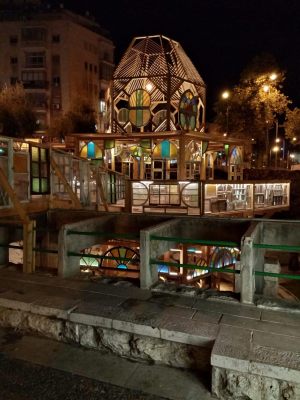

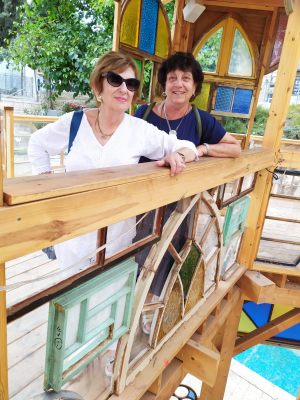
After a walk around the
Machaneh Yehuda, an
excellent fish lunch and some shopping we crossed over to the Nahlaot
and
visited Maureen’s studio to see the watercolors she will be exhibiting
at an
exhibition in Yafo soon.
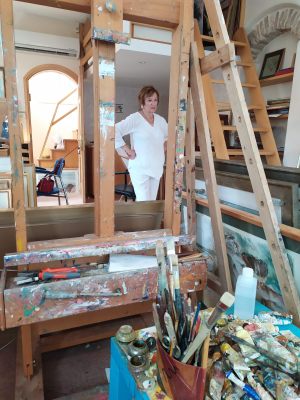
Braving the traffic we left
Jerusalem
stopping on the way to visit Yona Weismann at Protea Hills. She was
full of
stories and bubbling over about the tours and lectures and people at
the
complex. If there is one thing that would induce me to move to such a
complex
it would be the spotless upkeep and cleanliness of the grounds – quite
unlike
our neighbours who discard their trash with abandon in the public area.
While standing on the balcony
and admiring
the view Yona recognized someone sitting below whom she said we should
meet,
casually mentioning his name. “David Darom?” both Caroline and I
exclaimed. We knew him from our days in Eilat.
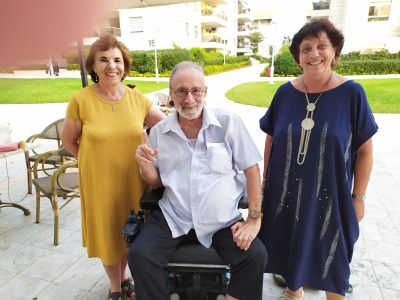
Dr David Darom is a marine
biologist and well-known nature photographer. He was head of the
Scientific Photography Department at the Hebrew University for many
years, and has published many books. For a time he was Head of the
Interuniversity Marine Laboratory in Eilat before the appointment of
Ilan Paperna, the late husband of my very good friend Yael. Among
his lesser known publications is "A Guide to the
Coral World", a booklet written by David Fridman and Eitan, with
photographs by David Darom.
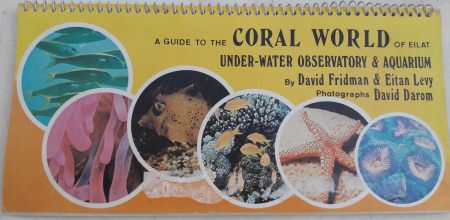
Column 46 - Avram Bortenstein and children rescued after the Shoah.
Every year on Yom
HaShoah (Holocaust Memorial Day) we
remember family members and mourn all the innocent Jews murdered by the
Nazis
and their collaborators during the Shoah.
This year, however, I would like to
share with you the story of our dear relative Avram Bortenstein ז"ל who was in
the Russian
army and his efforts after the Shoah
to help identify hidden children in
Poland.
A few months ago with grandchildren
and friends we visited the
Children’s Museum at Kibbutz Lohamei Ha’getaot in
the Western Galilee. As part
of the tour there was a most moving one-person play about a Jewish
child who
was hidden in a convent during the war. The play ends with the efforts
to remove her at
the end of the war.
Her story was very similar to another story, one we had heard from Avram Bortenstein. He was was born in Poland and during the war fled to Siberia where he joined the Russian army and was sent to the front against the Nazis. In 1945 he was released in Estonia. He went to a synagogue where he met a man called Moshe Drue (my father’s uncle) who said he had three daughters and he should come to his house and meet them. He did; chose Riva and they married. Their eldest child Yaffa was born in Poland. They went to Warsaw where he enlisted in the Ichud. They were sent to Bilave near the Czechoslovakian border where they stayed in a large house.
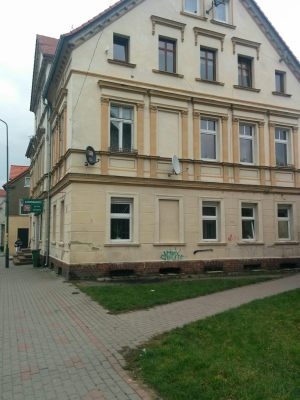
The
house in Bilave. To the left of the house is a sign – it is still a
grocery
store.
Riva and Avram lived on the second
storey and ran the grocery store on the ground floor. Other volunteers
also lived
in the house. In the attic were the children who had been removed from
convents
and monasteries, where they had been placed by desperate parents during
the
Shoah. This
house was one of a network
of children’s homes established throughout Poland by the Central Jewish
Committee. Various organizations and Zionist youth movements took upon
themselves the identification and removal of these children. They were
seen as
the nucleus of rebuilding European Jewry, this time in
Palestine/Israel. The Ichud
collected the children into safe houses, like the one in the picture
above, called
‘kibbutzim.’ They provided a
temporary home for the children and prepared them for immigration to
Palestine.
It seems there were lists of
children placed in Catholic institutions
and where they were hidden. Avram’s role, with others, was to identify
these
children, persuade them that it was now okay to admit they were Jewish
and take
them to their safe house in Bilave where they were given new clothes
and after
a time transported across the border and taken to Palestine, later
Israel. Among
the young strong men he enlisted included one Felix Karsblad who later
married one of the other Drue girls, Mussi. They were active from
1945-1950
when they made Aliyah.
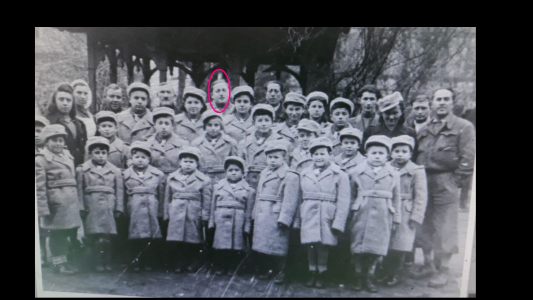
I asked Avram’s son Yaakov how they
could know who was Jewish but he didn’t know. Eerily similar to the
play we saw
where the little girl denies she is Jewish, Avram recounted stories of
children
who, told they must never admit to being Jewish, defiantly denied that
they
were Jewish, even when faced with a relative, until they broke down and
came
with him.
Talks with Avram Bortenstein and his children
Kibbutz Lohamei Ha'getaot
Yad Ve’Shem

Eitan writes: I've taken the liberty of hijacking Doreen's Column
and posting a picture of the delightful card she gave me on my 79th birthday.
Column 45 - Hebron with Breaking the Silence
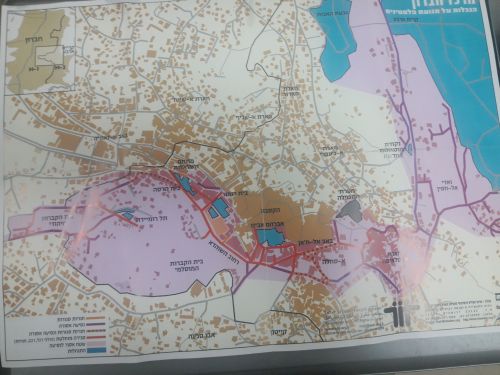
Some 300 people joined the Breaking the Silence Tour this
last
Friday, 6 buses one of them English and the rest Hebrew. This may
explain the
surprisingly large number of soldiers and policeman all around as we
walked in
Hebron. There was a steady stream of settlers and chabadnikim taking
photos and
videos of us much of the time.
Hebron today is the largest Palestinian city in the West
Bank, with
35,000 Palestinian residents. Within the city are 5 settlements where
some 850
settlers live. Hebron is not part of the
Oslo Accord Areas A, B and C signed between Rabin and Arafat. Instead
Hebron is
divided into H1, exclusively Palestinian and H2 virtually Palestinian
free
areas .
It is unique among the West Bank settlements in that the
number of
settlers has remained stable over the years, unlike other places. On a daily basis 600 soldiers guard the
settlers; on weekends this number is increased to 900. Looking at the
map: the
heart of the city is crossed by Rehov Shuhada, today totally out of
bounds to
Palestinians. Purple streets are where Palestinians can walk but not
drive.
Stone blockades bar Palestinians from entering these streets. 41% of
Palestinian shops in Hebron, (in what has become the settlements’
empire) have
either been closed or abandoned due to lack of custom.
Our first stop was at Park Kahane. Kahane founded the
Kach
political party, which was outlawed because of its racist policies.
Today
Baruch Marzel heads the continuation of the Kach party and lives in Tel
Rumeida
in Hebron.
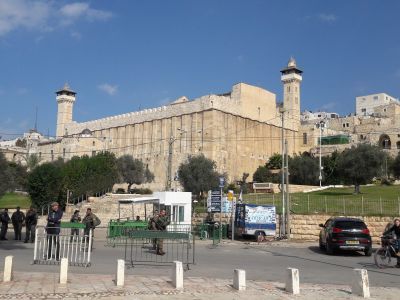
In the park is the much visited grave of Baruch
Goldstein. In
February 1994 he went into the mosque at the Cave of the Machpelah and
while
firing 5 magazines killed 26 Muslims at prayer. This horrible
unprovoked murder
changed Hebron. This is when the shops were closed and streets made
‘sterile’
physically separating the Palestinians from their houses and shops in
the name
of protecting the settlers from the anticipated wrath of the
Palestinians.We viewed the beautiful Herodian building
over the
Cave of the Machpelah. It is
holy to both Jews and Moslems (and increasingly to Evangelicals). By
tradition
this is where Abraham and Sarah and the other patriarchs, Isaac and
Jacob and
matriarchs Leah and Rebecca are buried. (Rachel is buried near
Bethlehem.)
Today there are separate areas to pray for Moslems and for Jews and for
others.
On about 20 days a year, because of religious holidays the site is open
to one
religion only.
We walked along Shuhada Street, most of which is forbidden for Palestinians to access – the result of Baruch Goldstein's terrorism. This eerily closed and quiet street had once been the thriving central commercial and market area. Today the shops have either been forcibly closed or abandoned. On the floors above were windows with shattered glass and iron bars. 42% of the apartments have just been abandoned by their owners. Where Palestinians live today the windows have heavy netting over them to prevent settlers from throwing rocks into their apartments. Since they have no access to Shuhada Street they have to walk across the roofs of other buildings to get to their own places. The soldiers also walk along the roofs for routine exercises and when they enter apartments to check the inhabitants.
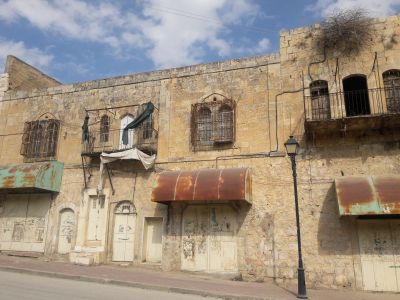
The settlements within Hebron are Avraham Avenue, Bet
Romano, Bet
Hadassah, Tel Rumeida, Givat Haharsina and Bet Rachel/Bet Leah. 15 families last March entered some
apartments in a disputed building on Shuhada Street, Bet Rahel/Bet
Leah. The
anomaly is that the Hebron municipality supplies services like
electricity and
water to the Palestinians in the building while the military government
supplies it to the settlers.
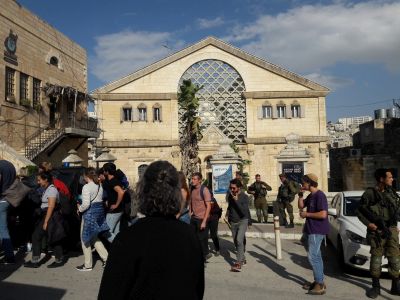
Bet Hadassah was built in 1893
as a
hospital to serve Hebron’s residents, both Jewish and Muslim. It was abandoned in the 1929 riots.
In 1979 a
group of women and children took over the building. Today the
settlement has
expanded to adjoining buildings. None of the descendants of the 1929
massacre
live in Hebron today.
After Baruch Goldstein’s gunning down
Palestinians at
prayer in 1994 the shops near all the settlements were closed forcibly
– not
due to Palestinian violence but to prevent outbreaks of violence.
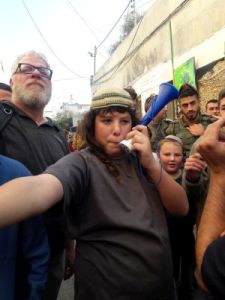
Towards the end of our tour – which we didn’t manage to
complete –
we did meet hostility from settlers. While we were trundling up the
hill to Tel
Rumeida we saw in the distance a group of young men, settlers. They
stopped
away from us and eventually made their way to us, clapping their hands
and
singing. When they reached our group they formed a circle and started
dancing
and singing loudly. This was the very place where Leor Azaria shot the
wounded
Palestinian. We continued up the hill but were then stopped by a group
of women
and children. The youths had plastic vuvuzelas that they blared in our
direction, making it impossible to continue. Although there was no
threat of
physical violence, one woman was shouting at us that we didn’t care
that a
Jewish man had been killed here (we didn’t know to what she was
referring), a
young woman was shouting and crying at us, the youths were blowing
their horns
and police and army were all around. At this point the army declared
Tel Rumeida
to be a closed military area and we had to leave.
We walked down the
hill to a
house owned by a Palestinian and sat on the grass below the olive
trees,
enjoying the rest after hours of walking. A young Palestinian, a member
of a
Palestinian organization advocating non-violent methods of opposition
to the
occupation, began to speak to us. After a few minutes soldiers appeared
and
announced that this too was part of the closed military area and we had
to
leave.
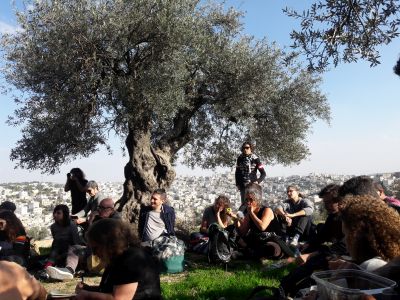
I came away with the feeling that the settlers are the
ones in
control and in the name of protecting them the army is forced to do
their
bidding – even when it is the settlers who commit violence.
Column 44 - Breast Cancer
I
am back home after a lumpectomy the day before yesterday. Already I
feel much better and
am walking the dog. Happily washing dishes and lifting things are not
allowed.
It
was a most interesting process. The day before the op I met with the
surgeon
and the anesthetist .Then with the doctor who had done the lumpectomy
and now
needed to find the growth; she had then said it was so small that she
had
inserted a clip by the growth. She couldn't find the cancer under an
ultrasound
so off I went to have a number of mammographies, first to find the spot
(barely
visible) and then to insert a special hollow syringe to the spot
(another
mammography) to make sure they had reached the spot. Then a thin wire
was
inserted through the syringe. After the syringe was taken out another
mammography to make sure the wire was still in place, after
which it was
taped down for the op the following day. I was sure I would get breast
cancer
from all that but they assured me it was like 2 hours in the sun.
Afterwards
I had to have isotope injections put in my breast. Although there
is no
sign of the cancer spreading, the first place that it would is to
certain lymph
nodes and these need to be identified.
My
family and friends kept me company and kept my spirits up all day.
The
next day, Thursday I was the first to be operated upon. They had a hard
time
finding my veins and the blood pressure machine was so tight it hurt
me.
The surgeon stood by me and held my hand until she took over and
inserted a
needle into a vein. Then I was out and can't tell you anything.
But
I was informed that during the op, after removing the
growth (two attempts) and removing 3 lymph nodes, I received in the
breast 35
minutes of radiation and only then was I sewn up. I can see a brown
burn mark
(not sore) on the outside of my breast. This is the latest technique
for small
slow growing cancers –Intra-Operative Radiation therapy or IOR. The
advantages are that there is no need for external X-ray treatment and
should
the cancer return (no expectations in my case) there remains the option
of
external radiation. If you have external radiation straight away and it
returns
the only alternative is a mastectomy. Of the four operations that day,
I was
the only one who had that treatment.
So
now back home and as I said feeling better each hour. I am under strict
instructions to rest - "What's that?" I replied. But yes, I am taking
it easy and resting a lot.
I
hope I haven't bored you but breast cancer is so common today I thought
the
advances of medicines and options for the patient important to know.
So
I feel much better today Saturday. Of course walking the dog helps! And
needing
to look my best when the grandchildren come to see me - bearing
homemade shushi
(see picture) - as I said this time I
really would not cook.
Column 43: Thoughts on
a visit to Riga
When Eitan had to attend a bridge meeting
in Riga Latvia, it gave me a chance to make a pilgrimage of sorts.

The only synagogue still standing and functioning in Riga today is the beautiful Peitav synagogue, built in the Art Nouveau style. Unlike the other synagogues which were beyond the moat of the Old Town, the Peitav Synagogue in the Old Town was surrounded by buildings on all sides. The pastor from the nearby Reformation Church warned the Nazis that if it was burnt like the other synagogues in Riga it could lead to the whole area burning down. The pastor may also have hidden and saved the torah scroll. The building was used as a warehouse during the Nazi conquest. When the country returned to Russian control it did function as a synagogue but became much neglected as no repairs were made. Only in 2008, some 10 years after Latvia gained independence, was the building fully and lovingly restored, with the addition above the Aron Kodesh (Holy Ark), in Hebrew of Psalm 124:6 Blessed is the Lord, Who did not give us as prey for their teeth.
A
relative on my father’s side, Florence
Levine, has submitted Pages of Testimony to Yad Vashem giving details
of the
murder of my grandparents and their youngest son Avram during the
Holocaust. My father never told us
anything except to say
that his family had been burnt in a synagogue. Only through Florence
did we
learn that in fact Motel and his son Avram had been taken from the
streets of Vilna
and forced marched to Ponar where they were murdered and presumably
buried in
huge pits prepared for oil installations by the Russians. Nessie, my
grandmother, ran away and reached Golshany (Olshan) in Byelorussia.
News
reached the family that she had been burnt in a synagogue and for years
we all
presumed it was in Olshan.
(The remains of the Choral Synagogue)
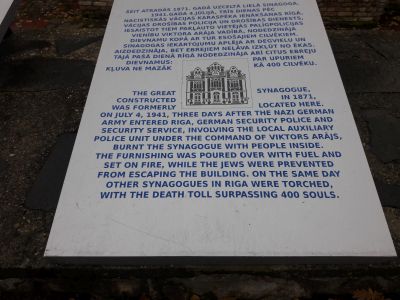
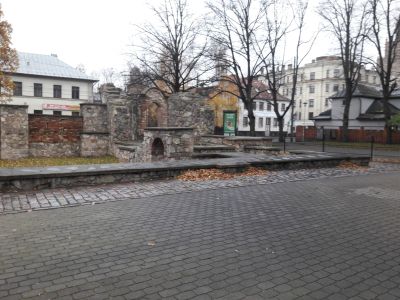
A few months ago, while trying to verify this at Yad Vashem, it appeared that there is no record of Jews being burnt in a synagogue in Olshan. Hundreds, if not thousands of synagogues and houses of prayer were burnt by the Nazis but the only record I could find of Jews being burnt in a synagogue was in Riga.
I believe my grandmother Nessie Glasser was amongst those pitiful Jews burnt to death in the Choral Synagogue on 4 July 1941. Adding to the horror is that 4 July is the date of my late father’s birthday.
For more on our visits to Riga see here , here, and here for a short visit on our way to Liepaja.
Column 42: For Lotem on her batmitzvah (October 2017)
Granddaughter Lotem is very creative and sews and prepares many articles from material. Together with daughter Vered and the Ron family we gave her a sewing machine for her batmitzvah. This is what I wrote to Lotem about the importance of sewing machines in my family.
Lotem, it is with special pleasure that we are giving you a sewing machine as a present for your batmitzvah because sewing machines played a very important part in our family’s life.
My father (your great-grandfather Maurice) was brought over from Vilna in Eastern Europe by his uncle Yahne Glasser.
He said goodbye to his parents not knowing whether he would ever see them again and made the long journey to South Africa by ship. At first he worked at Peel’s grocery store in Johannesburg. My father always wore very thick dark green glasses. He claimed that he had ruined his eyes working at the store. He had to sit in a dark basement and in front of a single light pick up each egg and hold it up to the light to make sure it was fresh.
When he had earned enough money he brought his brother Mike over to South Africa. They did not earn enough money to bring Avram their youngest brother nor their parents to South Africa and they died in the Holocaust.
When he was courting my mother (great-granny Gertie) and took her to a restaurant she was very impressed how he knew the best of foods. He had learnt from selling these foods to people with money.
When they got married they opened a fish shop in Pretoria, a town near Johannesburg, and supplied the British army with fresh eggs.
Later his Uncle Yahne offered him a partnership in a clothing factory in Johannesburg. My parents moved there and they both worked in the factory. They knew nothing about making shirts and my father described how he took a shirt apart to see how it was made.
They were very successful and after a few years my mother didn’t have to work anymore. My father made sure that he employed his brother and other relatives as well as my mother’s brothers in the factory called Star Shirt and Clothing Factory. Eventually he had three factories – in Rhodesia (today Zimbabwe) and Windhoek (today in Namibia) and in Johannesburg
I have wonderful memories of that time. In the factory there was a very long table with a special roller to lay down layers of cloth which would then be cut into pieces for making shirts and trousers. I loved to run and push the roller from one end of the table to the other as the cloth was laid down. But I was a hyperactive child and ran which meant the workers had to run with me.
There were hundreds of sewing machines in the factory but my favorite was the machine that sewed on buttons. I felt very grown up using it as they were always warning me about keeping my fingers clear and not sewing my fingers to the shirt.
I went to Windhoek with my father a number of times. The Herero women were very exotic. They were tall and wore colorful long dresses and headdresses that they wound around their heads. I was a very skinny child (!) and remember sitting in a basin to wash myself. I must have been about five years old as this was before I could read. My father would later tell me how at breakfast I would solemnly take the menu – often holding it upside down – pretend to read and then order bacon and eggs every morning.
Eventually my father closed the three factories and moved his business to Durban where we lived until Saba and I got married and made Aliyah to Israel.
When Saba and I got married my mother taught Saba how to sew on buttons, telling him that I would never sew anything. He is very handy with a needle and cotton and can repair suitcases with a special curved needle.<see picture> During the Yom Kippur war, when I was afraid that our whole life would change, I quickly sewed your one-year old dad two pairs of bibbed trousers. On rare occasions I’ve also been known to sew on buttons or repair a hem.
So dearest Lotem, you can now understand the pleasure that giving you a sewing machine causes me.
Mazal Tov
Column 41 - Impressions of our cruise to Iceland (August 2017)
Read Doreen's account, with pictures, of the cruise to Ireland, Scotland, Iceland and Faroe.
Column 40 - A short visit to Vienna (July 2017)
Click here to read my acount, with pictures, of a short visit to Vienna
Column 39 - Donkey Milk
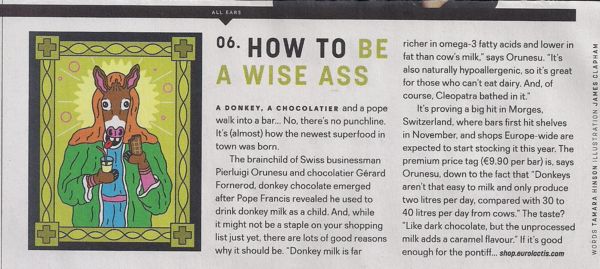
Donkey milk came into our lives quite suddenly. In February walking through the Placa area in Athens and looking for something unusual to take home, I was delighted to buy a face serum and a body lotion made from donkey’s milk!
Vered reported that although she has started laughing rather loudly of late, she is delighted with the serum.
And that was that, or so we thought, a
peculiarity of Greece where donkeys in Santorini are still used to
transport
people up steep hills. Now that animals’ rights groups are denouncing
the use of
the overworked donkeys, the donkey owners are looking for another use
for
their donkeys
On
the way to Lausanne
for a bridge meeting recently, while scanning through the EasyJet
magazine, I
came across an article about milk made from donkey chocolate. Hmmm, new
fad
food I thought to myself and promptly forgot about it.
Last
Sunday when friends
Pierre and Francoise Collaros took us to visit some quaint villages by
Lake
Leman/Geneva, we stopped at Morges, just as the Saturday market was
closing
down. By this time we wanted a bite for lunch and after passing
numerous cafes,
Eitan suddenly declared, “This one looks fine.” We went in, saw that
the
sandwiches looked delicious and sat down. Unlike other restaurants that
have
pictures of scenery on the walls, this restaurant (didn’t even notice
the name
as we came in) had different pictures of donkeys. While
waiting by the cashier to order my
beetroot bread and brie sandwich, I noticed that behind us was a table
full of Easter
eggs and Easter bunnies. When asked whether they had plain chocolate
she said
they only had donkey milk chocolate! So we bought the small expensive
slabs of
chocolate to take to our grandchildren back home.
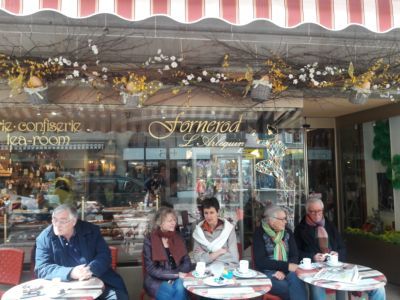
After
leaving the café I
turned back to take a picture of the name that was on the glass front.
Imagine
my surprise when on the flight back home I reread the donkey chocolate
article
and realized that quite by chance we has stopped to eat at Fornerod Tea
Room,
the cafe of the chocolatier who developed donkey milk chocolate!
Of
course everyone knows
that Cleopatra bathed in donkey’s milk to keep her skin looking young
and
fresh, but so did Poppaea
Sabina the Younger, the
second wife of the Emperor Nero
as did Pauline
Bonaparte, Napoleon’s sister. I hope the donkey
milk body lotion will have the same effect on me. HEHAW HEHAW.
The
yield of milk from a donkey is much less than from a cow, which
explains why it
is so expensive. But already in the Roman period Hippocrates, the
father of
medicine, recommended donkey milk for various ailments. Today it is
recognized
as closest to breast milk, contains more
omega-3 fatty acids and enhances immunity,
which may be helpful for people with conditions like asthma,
eczema, or psoriasis.
Donkey milk, anyone?
.
Column 38 Our trip to Potugal
Click here to read my account - with pictures - of our trip to Portugal in December 2016
Column 37 - Fire terrorists (26 November 2016)
This past week we are faced with a new form of terrorism - fire terrorism. It is easy terrorism; no need to confront a person and stab them. Just secretly light a match and watch with bitter glee as forests burn to a cinder, as animals unable to flee are charred and as whole lives go up in flames. Our hearts go out to all who have lost their houses. But just as we ourselves condemn the settler movement and especially the hilltop delinquents who uproot olive trees and cause damage to Arab houses and property, so we need to distinguish between the fire terrorists and the law-abiding Arab population.
There are a few events which remained burned in memory: "Where were you when..... Kennedy was assasinated, when Rabin was murdered,... and when the Twin Towers fell?" We were in Maplewood NJ staying with Vered and family and actually at the local train station on our way to Manhattan, We stood in disbelief in front of the TV screen airing again and again pictures of a
Hours later a message arrived from Aviv. He was safe. They were forced to land somewhere and he and a few other travellers had bought a car to drive it back to New York as the only possible way to get home.
That day changed many things. Al Kaieda's attack on the financial, military and aborted attack on the US government changed all our lives. If we thought the world a violent place before that, we could not imagine how violent and fraught with terror the world would become. Apolcalyptic scenes from ridiculous science fiction movies suddenly appear prescient.
So 15 years later,
Skyscrapers rise on all sides of the renewed Trade Center but not where the Twin Towers stood. Two black square pools with water rushing down into a large pools and then into what looks like a bottomless black hole, symbolizing absence and loss. The theme is the Reflection in Absence. The veils of rushing water must symbolize endless tears but also serve to drown out the noises of the bustling city around, making it a place of reflection and sombre meditation. Around the rim of the pools are the names of all the victims of that horrific day cut out into the bronze rims surrounding the pools - the victims who died in the Towers, the airplanes and the first responders who died trying to help trapped victims in the conflagration as well as the names of the 6 people who died in an attack on the Towers in 1993. Here and there are white carnations inserted in the cut out names, honoring the birth dates of the victims. The area is surrounded by Swamp Oaks, trees which grow in New York State, Washington and Virginia where the planes crashed. Of the 2,977 victims, 1,115 unidentified remains are at the base of the Memorial, in the space between the bottoms of the reflecting pools.
We were moved by the simplicity of the memorial and the stories of the many who gave their lives to help others. If you visit New York please go on a guided tour of the Memorial and Museum; it will add immensurably to your understanding of that dark day that changed our history.
There are some pictures here and one here.
Column 35 July 2016 - The "Road to Recovery concert" conducted by Maestro Mehta
We
have all attended concerts that
were wonderful, inspiring or delightful; not often does one have the
privilege
of attending a concert that moves people to tears. Such was the benefit
concert
held at the Elma Arts Complex in Zichron Yaakov with Maestro Zubin
Mehta to raise funds for Road to Recovery, an organization that
transports very sick children
from the West Bank and Gaza to hospitals in Israel for treatment. Like
all the
organizers and volunteers in the organization, everyone donated their
services for
the success of the evening, including Mehta, the orchestra, comperes,
singers,
choir, the Elma Arts Complex hotel and the list goes on.
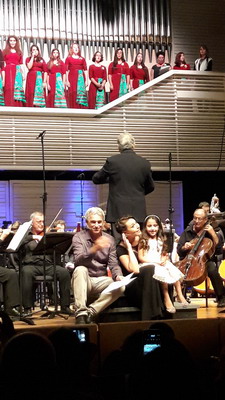
The
convert was relayed live on facebook. If you go to this
link you will
hear
the soprano Nur Drausha
sing O Mio Babbino Caro
from Gianni Sicci by Puccini, a rousing three-horn piece by Leroy
Anderson, and a
girls’ choir from the Emek Yizreel composed of both
Jewish and Arab singers. Playing in the orchestra
were young musicians from Nazareth. But perhaps the highlight of the
evening
was the young children themselves. Roni Porat, who together with Mira
Awad
compered the evening, called four young children to the stage. The
children
were given tambourines, a horn and a whistle and with the help of the
medical
clown Sirhan Mahmid were instructed how and when to make music. We the
audience
had to clap three times on cue. The orchestra played Mozart’s Toy
Symphony
without the help of a conductor because Mehta was busy playing the
recorder
while we all made the appropriate sounds.
When
the orchestra played John Lennon’s Imagine
a young girl, Hamsa Masari, was called to the stage. Mehta had helped
bring her from a
border crossing to Tel HaShomer Hospital for tests to ascertain that
her cancer was in
remission. When she sat on Mira Awad’s knees and sang, it
truly was
an emotional and magical moment.
As
I was walking out I was delighted
to spy Tamar and Jimmy Rabinowitz together with Frankie Jaffe and her
husband. They too
are
volunteers, as is old Dubanite friend Issy Levitan from kibbutz Yizreel.
I
am always proud to be a volunteer
to an organization that really makes a difference to so many people who
otherwise could not afford to come to the hospitals for treatment.Road
to Recovery works toward
building
bridges of trust between Jews and Palestinians and offers hope to
parents and their children for a better future.
Click
here to see a video of Zubin Mehta and Hamsa Masari and about Road to Recovery. Highly recommended.
Readers of hebrew can read an interesting article
and interview that Zubin Mehta gave to the newspaper Yediot Aharonot.
Column 34 - July 2016 Our visit to Moscow
We had a most interesting visit for a few days to Moscow. Read my account of the visit (with pictures) here.
Column 33 - May 2016 A visit to Jenin
I am a volunteer for the non-profit "Road to Recovery", an organisation that transports Palestinians needing special medical care from the West Bank Territories to Israel hospitals.You can read about the organisation, which now transports 80-100 patients each day, on their site and see a CNN featurette about Yuval Roth the founder of the organization.
To show appreciation for the work of the volunteers, Ibrahim Ramadan the Governor of the Jenin District (Area A of the West Bank) invited them to visit Jenin. We were delighted, as Jewish Israelis are not usually allowed to enter Area A which is under total administrative and security control of the Palestinian Authority. Before the Israeli side agreed to our leaving Israel we each we had to fill out forms weeks before and were warned that without our Israel Identity Cards we would not be allowed in. Usually a driver's licence is sufficient identification in Israel. We gathered at Jalame checkpoint, where Alexander, the civilian in charge of the checkpoint, warned us that Israel has no presence in Area A and we were entering on our own responsibilty. In addition to telling us about the workings of the checkpoint he informed us that all cucumbers pickled in Israel come from this area of the West Bank! Our group, shepherded by Alexander, crossed over without going through any security checks.
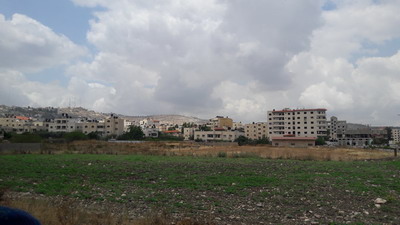
In contrast to our having to wait weeks for our security clearance, non-Jewish Israelis only have to present their ID's to pass and they do! In fact Alexander told us that about 10,000 cars pass every Saturday. Evidence of the importance of this economic exchange could be seen in the many garages and related shops, shops selling household furnishings and sanitary equipment. The houses in Jenin area were nice and the areas in front of the shops were clean. However we noticed that there was a lot of dumping in open spaces - not unlike areas of Netanya! - and the refuse collection is obviously not of premier importance The cars seemed in good condition and not too old. I seem to remember hearing that used cars were not allowed to be imported from Israel.
The women in the street wore head covers but we saw no-one with the ra-alah covering their whole face. In the municipality building there were women working there with uncovered heads and revealing clothing.
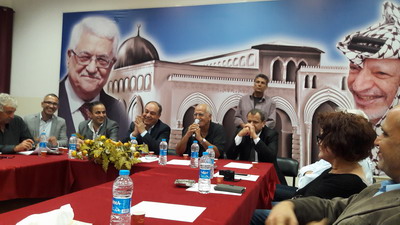
In the municipality we sat around a large table which included at its head Governor Ibrahim Rahamin, Yuval Roth, the head of the Jenin hospital and Yaziz the Israeli co-ordinator of Palestinian patients at Rambam hospital. Ibrahim Rahamim spoke about the need to transform the tears of children into laughter. He said that while Peace is made between governments Road to Recovery is working towards that goal by helping people in need. It is a bridge to peace. He echoed the cry of all us us when he said that it is so easy to make war; with the same effort why can't we bring about peace. He commended Road to Recovery on their efforts in working towards this goal by helping people in need and thus recognizing each other and preparing the road to shalom.
The planned visit to the hospital had to be cancelled as it was extremely busy there and there was some unrest at the refugee camp next to the hospital, so unfortunately after lunch (a shwarma in a baguette) we returned to the checkpoint; a quick check on our ID card, and we were back in Israel.
See also Archives of This Week's Picture.
Column 32 - Jerusalem in Rome
We visited Rome for a few days. While Anthony was busy with a bridge seminar I did some touring and found the connections between ancient Rome and the Holy Land fascinatin. You can read my impressions in Jerusalem in Rome.
Column 31 - On the Glazer Family
In response to a
request from
my cousin Vanessa (Glasser) Tarazza in Johannesburg, I sent her some
information about the family. I have slightly changed what I wrote, to
make it
easier for our grandchildren to understand. My father always insisted
that
‘Glazer’ was the correct translation of the family name from the
Yiddish and
not ‘Glasser’ and that the rest of the family had got it wrong.
The Glazer/Glasser
family
came from Lithuania. Saba does a lot of research for the family tree
with input
from some relatives. I only remember a few stories from my childhood
and am so
sorry that I didn’t pay more attention.
The
furthest the Glazer
family can go back is to Hessel Gordon who married Elka in Lithuania in
the
early 1800’s. That is all we know about him.
Vilnius was the
center of
Jewish life in Lithuania. Everyone spoke Yiddish (the revival of Hebrew
was
just beginning). Over 40 % of the population was Jewish. In addition to
the
many synagogues and yeshivot it was an important center for the Bund, a
socialist party that worked for equal civil and political rights for
Jews with
the rest of the population. There was a movement called The
Enlightenment that
offered Jews a secular alternative to the life of study in the yeshiva;
it
offered an entry to the sciences, literature and art. We don’t have
important
people in our family but it was at this time that Einstein, Marc
Chagall, Freud
and many Nobel Prize winners were active.
Mottel your great-great grandfather married Nessie Schank who came from Tartu in Estonia, possibly when he was a soldier in the Russian army. They had three sons, Morris, (my father) Michael and Abrashka. They lived in Vilnius. We have cousins who live in Kfar Meishar, Gedera area. Yaffa’s grandmother was Nessie’s sister. Yaffa told us that Mottel and Nessie also had a roadside inn. Travelers would change their horses, sleep over and eat there. Whether this was the same one as their father Itzik Ber’s we don’t know. Both Denise Braverman and my cousin Vanessa in South Africa are named after her.
Why Joe chose to send money to Morris my father to emigrate we don’t know, but Morris left his family for South Africa. There is a picture of the family in Vilnius taken in 1929 when Joe returned for a visit. You can see the picture at http://www.eitanlevy.com/Vilna1929.html. My Dad is not there but you can see the rest of the large family. Except for the grandparents none of them look particularly religious. There is a branch of the family called Gordon and they were religious. Not all the family members are in the picture. Some emigrated to South Africa, America and Australia before the war. Those that didn’t died during the Holocaust.
Mottel, Abrashka and their cousin Elke were among the first to be rounded up off the streets of the Vilna ghetto in August 1941 by Lithuanian collaborators and marched to Ponar, under the pretext of going East to work. Ponar or Ponary was a Russian oil installation site where deep pits had been dug for oil tanks. The Jews who were rounded up were forced to give up their belongings and then forced into those pits and shot. (http://www.holocaustresearchproject.org/einsatz/ponary.html). Nessie Glezer managed to escape the Vilna ghetto and made her way to Olshan – possibly trying to return to Estonia. Whether she did it alone or with others who were fleeing it was a brave and dangerous act. In Olshan (Belorussia) she was herded into a synagogue with other Jews and the synagogue was burnt.
After the war Yaffa’s mother Riva made her way to Vilnius to look for her aunt Nessie. Living in their house was a strange Polish family. Riva said that all the original furniture was in the house including the mezuzah on the doorpost. Riva was horrified and ran away. She and her husband Avram Bortenstein came to Israel as did her parents and both her sisters, Mussi who was married and an accomplished pianist and Hanna, who was single and crippled. Their brother who was a film director was never allowed to leave Russia, and we have contact with his son, Heinie (who lives in Estonia).
My Dad always said
that his
whole family was burnt in a synagogue. A cousin, Florence Levine in
America
says she remembers how my Dad would sit with her mother Riva and cry as
he
talked about his family. He must have known the details of the death of
his
family, but for him his whole family had been burnt in a synagogue. It was Florence who registered the names of
our grandparents with Yad Vashem Holocaust Names Project and supplied
us with
the sad details, because my father never did.,
Back to
Johannesburg. Uncle
Joe sold my Dad a partnership in Star Shirt and Clothing Factory. What
we were
told is that the factory was bankrupt. My dad started by undoing a
shirt to see
how it was made. My mother worked in the factory until they had made
enough
money and then stopped working. My Dad employed many family members
both from
his side and my mother’s in his factories. After the war when my uncle
Mike
came back from the army in northern Africa, he worked as a travelling
salesman
for Star Shirt. After he married Betsy they moved to Bulawayo where
Mike ran
Leonard Clothing. In 1955 we moved to Durban after my father closed his
factory
in Johannesburg and moved it to the Durban area.
My Dad never lived
in Israel
but visited often after we moved here. He died in Tel Aviv two weeks
before
Moran was born in 1973. My mother came to live in Tel Aviv; she used to
look
after our children when we went away – even then we liked to travel! -
and we
visited her often. She died in 1984.
You may be
interested in some
things I have written on Eitan’s site:
www.eitanlevy.com/picofweek_archive.html#21apr07
www.eitanlevy.com/picofweek_archive.html#ponar
Should anyone have
anything to correct or add, please do so.
Most
of my friends who learnt of
my support for Breaking the Silence (see previous post)
either ignored it or expressed
support for
what the organization is doing. However, they were critical of the
international airing of the reports about what really is
happening in the
occupied
territories, politely known as the West Bank.
No one suggested that their reports were fallacious, exaggerations or
slander.
But you know, these unpleasant things shouldn't be for publication; it
is a
family matter, best dealt with ourselves.
If we knew that the Israeli authorities were interested in
exposing and preventing
illegal land grabs or concerned how they embitter the lives of innocent
people
by unprovoked violent intrusions into their lives and houses at night,
then I
would agree that Breaking the Silence should remain quiet to enable
ongoing
investigations. But we know from regular exposures in the newspaper
(Haaretz)
that this is not happening.
Are we aware that by our very silence we are condoning what is
happening in the
occupied territories? Our silence does not distance us or protect us
from those
immoral and illegal acts; we are encouraging them to continue.
Do we condone those who remain silent when they hear of priests abusing
young
boys; or those who agree to the suppressing of reports on marital and
child
abuse amongst the haredi community; or those who did not
protest the divestment
of the Jewish people from their livelihoods, their property and their
very
lives?. But somewhere, sometime, one
must choose to take a stand.
And in Israel, who will ignore Mahsom Watch; who will choose to gag the
mouths
of soldiers who have done unmentionable things in the West Bank in our
name;
and who will turn the other page when we see democracy being twisted,
when
valid criticism is seen as traitorous.
I can no longer remain silent and have chosen to cautiously feel my way
back on
the hard path to my conscience and values, to my humanity.
Column 29 - January 2016 - A tour of the Hebron Hills with Breaking the Silence.
LAST Friday I joined a tour to the southern Hebron
Hills
with Breaking the Silence. About 10 people, including an Israeli woman
who
makes documentaries, gathered on the bus, with Nadav as our guide. (http://www.breakingthesilence.org.il/about/organization).
Nadav, a veteran soldier, explained that while serving (he was in
Hebron) the
soldiers are not aware of the overall picture. Only when piecing the
testimonies of soldiers together does the bigger picture emerge of the
cost in
money, effort of the army and what our soldiers are forced to do to the
civilian Palestinian population in the name of the occupation.
Unfortunately planned visits with Palestinians
didn’t work
out but we had an interesting encounter at Mitzpe Yair. Situated
on an isolated hilltop,
supposedly a neighborhood of Susiya a number of kilometers away, it was
founded
as a price tag for the murder of Yair Har Sinai. Today it sits off road
317,
unfenced, and consists of about 16 families in caravans and stone
houses. It is
a religious settlement, regarded as illegal by the Israeli regional
administration, with plans on the internet to expand the ‘neighborhood.’ Our bus driver was guided to stop at the
beginning of the dirt track that wound between some caravans. Within
seconds
men appeared and demanded that we leave their property immediately; if
we
wouldn’t comply “it will end badly.” When Nadav asked for 2 minutes to
explain,
a van came and blocked our exit. The
army was called, but there was nothing they could do. The soldier in
charge
asked the settlers to let us go. The army has no jurisdiction over
Israeli
civilians who are ‘accountable’ only to the Israeli police. And the
settlers
wanted us to know who on whose land we were and who the boss was. They
refused
and for about 30 minutes we waited in the bus, until the driver of the
van
sauntered over and moved his van just enough for the bus to squeeze
past. The
army jeep followed us for a while – to protect us or to see what we
were doing?
There is an ongoing legal battle for ownership over Susiya. It was declared an archaeological site and the Palestinians who dwelt there, some in caves, were prevented from continuing their traditional livelihood of sheep farming and vineyards and were expelled. See http://www.btselem.org/south_hebron_hills/susiya for a broader discussion of the battle. There is an Israeli farm right next to the ancient site today.
Many people say that a two-state solution to the
Israeli-Palestinian conflict is too late. When you see the massive
building,
expropriation of Palestinian land and pushing the residents to give up
their
farming practices and permanently remain in the urban centers,
concentrating its
people to a small band of land, there would seem to be no way to get
the
settlers to relinquish their settlements. At one point while we were
standing
next to the bus while Nadav explained something to us, a woman settler
who was
driving by stopped and demanded to explain things to us. When she
wouldn’t wait
for Nadav to finish she walked off loudly exclaiming that if we want
peace we
should leave it (peace/control?) to them.
With much pain, to me the future looks bleak
even hopeless.
Column 28 - Doreen's Shana Tova Letter - 2015
Dear Family and Friends,
As the Jewish New Year 5775 draws to a close and Rosh Hashanah nears, it is with mixed feelings that we greet the year 5776. A New Year is a time for renewed hope and fresh starts, but the present with its troubles cannot be shaken off.
On a family level we are well and busy. All our children and their spouses are in Israel and not only working hard but succeeding in their fields.
Vered works for Landa Labs as Vice President Business Development. Landa Labs (link) is working on alternative energy solutions and nano-technology in new materials. She has completed her international skipper’s license and loves it, and we are always happy to be invited for a sail. Her husband Aviv is Vice President of Business Development and Strategy works at Kramer - a large development and manufacturing company of technology products for commercial audio and video (link). He is a very keen photographer and has had photos shown at a number of exhibitions in Israel.
In Eilat, our son Aviv is the Scientific Director
of the
Underwater
Observatory and highly regarded in his field. A huge shark aquarium has
recently opened to international acclaim; Aviv was instrumental in its
realization
and smooth running. (link).
Daughter in law Limor was recently appointed as
Vice
President of Tamar Tavor Corporation in
Eilat. She is working very hard in her
new job
Itamar our eldest grandson has started high school
at the
same school in Eilat that our three children attended – we hope with
better
success than they had! (But that is for another time.)
His sister Amit is an excellent student; in
addition she is a great help to her mother and takes on many household
duties. Her
younger sister Ilai is to be commended on enduring the discomfort of
wearing a
brace for her back in the heat of the Eilat summer, while maintaining
her sunny
personality.
During the summer holidays we hosted six of our
grandchildren at our apartment in Netanya. Keeping them busy and
entertained
while cooking for them and cleaning up after them was our challenge and
delight
for the summer.
One of the highlights of this year was a 50-year
Habonim
Reunion at Tzora. Some 200 Habonim
members from South Africa, Israel and around the world gathered for a
magical
2-day experience, renewing friendships and sharing memories with much
joy and
much laughter.
On a more serious level we also evaluated how Habonim shaped our lives
and
values, with a sobering look at the reality of our lives today.
The mass immigration of people from Africa and the Middle East to Western Europe is most worrisome. One on hand we understand the people’s desperate need for a better life and on the other hand we wonder how this will effect Western civilization as we know it. We also fear the extreme rightwing parties that are rising in reaction.
And we haven’t even touched on global warming, depletion of fish in the seas and ….. and ….
This year Eitan and I celebrated
our 50th wedding anniversary. When we got married I suspect
we
foresaw that there would be tensions and arguments, but we never
foresaw that
after living together for 50 years the deep love that brought us
together would
still be alive, as well as a meaningful friendship, mutual
respect and
support for each other's success in all endeavours. We are very
fortunate
to be
alive and relatively healthy with so much sickness and death around
us. It is
something we fully appreciate.
As we look back on our lives we are so privileged
to have been able to exercise freedom of choice and movement, enjoyment
of wildlife and beaches and open
spaces.
It is with grave concern that we wonder what the future holds for our
grandchildren.
Although we are not religious, I’d like to end
with a quote by
my friend Rosie who lives in Berghaus in Germany: “In the words of my
mother,
if the dear god closes a door, he opens a window.”
May we all be proactive and help open that window
wide!
Shana Tova
Eitan and Doreen
Column 27: A Visit to
the North Norway Islands
Click here for a link to
pictures and Doreen's account of the visit.
This
evening we ate
camel stuffing and it was delicious. An event. Of course this requires
elaboration:
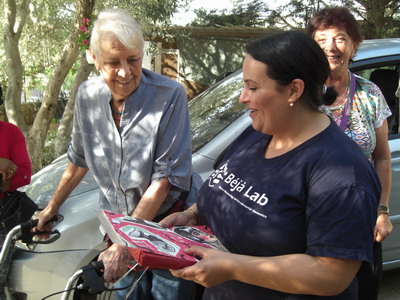
Our friend Dalia Lamdani, a food historian and writer, recently remarked in an newspaper interview (see Doreen's Column 23) , that although she had eaten many unusual dishes (including ostrich omelette at our house in Eilat), she had never eaten stuffed camel, and she “would like to try an ancient dish. I found the recipe in a book of Saudi recipes: A medium sized camel is stuffed with 4 lambs, which are stuffed with 10 chickens, which are stuffed with 40 kg of tomatoes and 150 boiled eggs.”

So some 50 family and friends were invited to Nof’s parents’ house in Baka el Gharbiya and Nof and Mussa her helper prepared dinner. A sheep was stuffed with a lamb which in turn was stuffed with chickens and they were stuffed with stuffed vineleaves, stuffed baby marrow and wheat grains. It was all wrapped in aluminium foil and cooked over a fire for 10 hours. Since they didn’t have a spit, turning it over was most difficult and parts of the sheep were still too pink. It obviously needed a few more hours for it all to be cooked through. But everything was delicious. There was enough food for another 50 people.
Nof’s mother Wijdan Atamna took us around her thriving vegetable garden and we sat in their garden on a cool summer’s evening, eating stuffed “camel” and enjoying ourselves.
I was asked to make a dessert and my original plan was to make a custard tart and a chocolate mousse, but opted for profiteroles instead as they were finger foods.Click to see the recipe.
Eitan had to plan an
international bridge tournament directors seminar to be held at the
beginning
of 2016 in Prague; I joined him and we extended our visit. We
stayed
at a simple Ibis hotel in the Smichov area. Although I usually like to
be in
the centre of a town, the tram and metro services were so frequent and
wide
ranging that it was not a problem.
On the
first day while Eitan and Josef Harsanyi were busy with meetings, Rosie
Kuntz
from Berghausen Germany and I went to the Jewish Quarter. We took a
tram into
town and walked to the Jewish Quarter or Josefov. 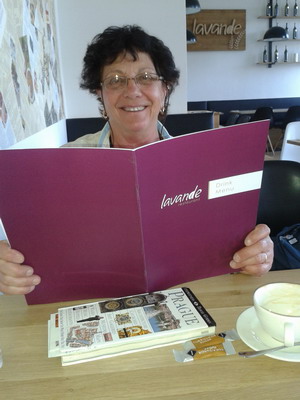
But after 10 minutes was it
obvious that we were walking in the wrong direction. After a few
attempts to
get help from passing people, we stopped by a van that was delivering
equipment
and asked the woman driver for help. Yes, we were totally wrong and far
from
the Jewish Quarter, which was too far and too difficult for her to
explain.
When we suggested that we take a taxi Mirka was
horrified because she said they
were very expensive (which they were) and insisted to taking us to the
Quarter
herself, although it was totally out of her way. She flatly refused to
accept
money for the trip. She recommended the Lavanda restaurant owned
by her
good friend, and we had lunch there one day and gave the owner a small
gift for
Marika.
The next day, when the meetings were over and our German friends returned home, Eitan and I began to explore Prague. On our first day we took trams and then walked up to the Prague Castle. In retrospect a bad choice as it was a bitterly cold and windy day and walking around was not much fun. Waiting in line to visit St Vitus’ Cathedral was miserable. But the interior was so lavish and of interest that it was worthwhile. St Vitus dance is the uncontrollable jerking that used to be caused as a complication of rheumatic fever; St Vitus is the patron saint of epileptics.
In the Church is a bronze ring said to be the one to which St Wenceslaus clung as he was murdered by his brother. Wenceslaus is also the patron saint of the Czech Republic and the main square is named after him. I’m sure that like us many vaguely remember the Christmas carol "Good King Wenceslas." It describes the king who goes out to give alms to a poor peasant on the second day of Christmas. During the journey, his page is about to give up the struggle against the cold weather, but is enabled to continue by the heat miraculously emanating from the king's footprints in the snow.
Our next project was to visit the Jewish Quarter. We had rented an apartment in Prague just over 15 years ago that overlooked the Jewish cemetery. We wandered around the quarter eventually working out where we had stayed in Brehova Street. We visited the Old-New Synagogue. As we looked at the tiny peepholes through which women could peer into the synagogue, I couldn’t help recalling how a few weeks ago in Eilat at a relative’s barmitzvah I was incensed that there was a separate women’s section that was separated from the body of the synagogue by a curtain. I guess we have come a long way.
Our most meaningful visit in the Jewish Quarter was to the Pinkas Synagogue. On the walls of the synagogue in the different rooms are inscribed the names of some 71,000 Czech Jews murdered in the Holocaust. The names are inscribed in row after row by place of residence and it’s very difficult to find specific names. Son in law Aviv Ron’s mother Tova Ron-Lederer made aliyah from Czechoslovakia with her parents. Some siblings remained behind and were killed, either at Terezin or at Auschwitz. We were able to locate the names of three of Aviv’s family, Ernst, Emile and Wilma Lederer from Volhyn, but couldn’t find the others.
It is always surprising to compare what Eitan and I remember of our trips – sometimes it’s as if we did not experience the same holiday. Eitan remembered a clock with Hebrew letters that moved counter clockwise. We found it on the clock tower of the Jewish Town Hall, below a clock with Roman numerals, moving clockwise.
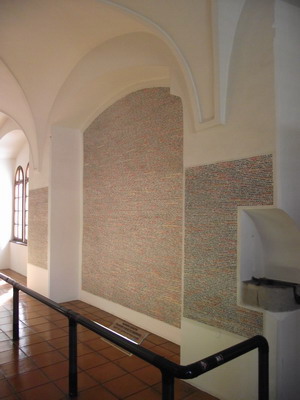
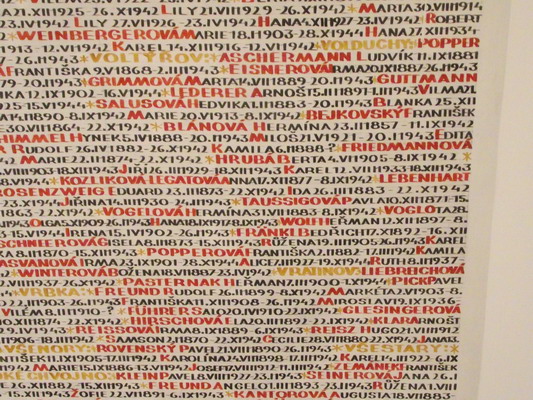
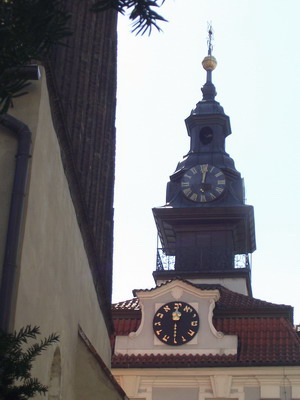

Under a cloudless blue sky with a bitingly cold wind we prepared to visit the famous Charles Bridge.
We first stopped at the Church of St Nicholas in the Little Quarter, noted as one of the must see sights in Prague, and rightly so. There was also an interesting exhibition of Pope Francis’s 2014 visit to Israel, the Palestinian territory and Jordan.
Then we stopped for coffee “At the Three Ostriches” just before the bridge. Today it is a hotel and restaurant but previously it was owned by a Jewish man Jan Fuchs who imported ostrich feathers (most probably from South Africa) and made his fortune supplying the feathers to the army and fashion designers. He had the front of his house decorated with paintings of ostriches, three of which remain.
The Charles Bridge has many interesting statues of saints, many of them familiar to us by name. Intriguing was a statue of Jesus on the cross with gold Hebrew letters “kadosh, kadosh” encircling it. It appears that a Jewish man accused of blasphemy had to pay for the inscription. Eitan was happy to see a statue of his namesake, Saint Anthony.

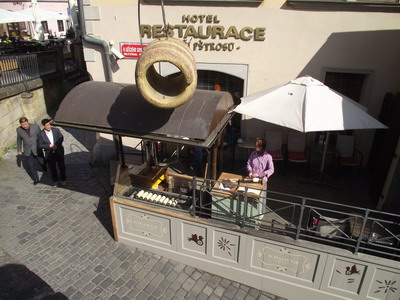
I also went to the New Town to the Church of St Cyril and St. Methodius. Yes, I am fascinated by churches and their art, but this visit was different. I recently read the book “The Killing of Reinhardt Heydrich: the SS Butcher of Prague” by Callum Macdonald. A rabid anti-Semite, Heydrich was the ruthless Nazi governor of Czechoslovakia and architect of the Final Solution. In 1942 two agents, a Czech and a Slovak, assassinated him. Afterwards they hid in this church together with other members of the Czech Resistance. Surrounded by the Nazis they all chose to commit suicide rather than be captured. A plaque and bullet marks on the outside wall of the church point to the place where they hid. In retaliation the Nazis obliterated two villages.
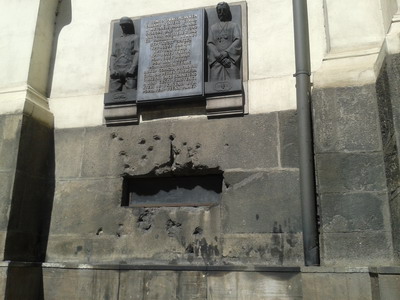


On our last day Milan Macura, President of the Czech Bridge Federatrion took us to Terezin.
The first time we had visited Prague we went on a tourto Terezin and visited the Jewish Museum there. This time we visited the small fortress where Jews and Czechs were imprisoned and tens of thousands died of torture and disease; survivors were sent to Treblinka and Auschwitz death camps.
In June 1944 The International Red Cross was brought on their infamous tour of the Ghetto to show how well the Jews were being treated. The ghetto had been beautified beforehand, a football match was staged and ill people were told to remain inside. The Red Cross never thought to look beyond what they were shown.
Food? Czech food is heavy on its sausages, pork, duck, and fallow deer, and meat in general, usually accompanied by some form of dumpling. . Between us we tried everything. Also some good pizza! And Chinese too!

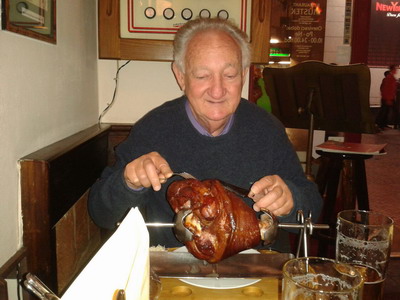
We thoroughly
enjoyed our visit and look forward to going there again in February
next year
for the bridge seminar.
Ella and Archie Ogden are friends from our first days in St Thomas. The last time we saw them was just after the September 11 terrorist attack when we flew to St Thomas, one of the few places we could visit then. Although many years have passed the warmth and shared interests have not diminished and when they visited Israel in November/December 2014 we had a wonderful few evenings together. (This Week's Picture Archives)
I remembered that in my cookbook I had written about the Ogdens, and what I wrote is reproduced here:
1 bottle club soda 1 packet dry onion soup
Preheat
oven
to 170°C/325°F.
Roast meat for 25 minutes per ½ kilo (1 lb). For rare
meat cook at 180°C/350°F
for 22 minutes per ½ kilo. Let rest 10 minutes; skim
off fat. Slice the meat. Reheat pan juices and serve as gravy with
potatoes,
rice or noodles.
Ella
and
Archie Ogden were lifesavers in St Thomas. Not the swimming kind, but
the
friendly, caring kind; they saw it as their duty to befriend all
Israelis (and
other strays) on the island and we were fortunate to be encompassed by
their
warmth and help.
At my surprise 50th birthday party, arranged by Nina, Ella said she also wanted a surprise birthday party. I rashly promised to make her one. Rash it was, because how could we then surprise her? Varda and I decided on a joint surprise party, for Ella who wanted one and for Marilyn Blackhall who didn't even want to celebrate her birthday that year.
For
weeks
Varda and I planned and organized: who to invite, food lists,
decorations,
music, presents. Since Nina and family were away in Maryland for the
summer, I
called and ordered a birthday verse. Despite her protestations that she
couldn't, she could and did, sending a delightful birthday verse which
was read
out during the evening.
The
party was
to be at the Pineapple pool. The problem was how to get the Ogdens and
the
Blackhalls there. When they arrived at our house the dining room table
was set
and Varda and Hanan were there. I
pretended to be completely flustered, claiming the air conditioning had
broken
down and the food wasn't ready. When
Marilyn suggested we just go out for dinner I had to say the dinner was
in the
oven, I just needed a few minutes to rest by the pool. Ella was
delighted, put
on her bathing suit and off we went to the pool. Imagine my surprise
when
no-one was there! The guests had hidden, and we were all
surprised when
they appeared. It was a memorable evening.
Column 23: Dalia Lamdani and the ostrich egg brunch

Dalia Lamdani, a very good friend of ours since our first days in Eilat, is an internationally recognized food historian. Our similar political views and shared love of good food have woven close ties between us during many meetings in Eilat, St Thomas, New York and Tel Aviv.
Earlier this month (July) Dalia published a book "A Journey Around the Table": It has no recipes but is about the part that food plays in our culture. We were delighted to see that she had included a brunch that we had made. Haaretz newspaper published a review of the book (calling Dalia “the Queen Mother of culinary writing in Israel”) and included a box featuring our ostrich egg brunch.
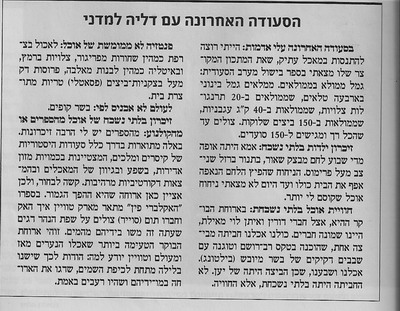
This how the brunch appears in
“A Potpourri of Memories”, the cookbook I
wrote.
Dalia Lamdani wrote about that memorable brunch in the magazine "La Isha", November 1994, under the title ‘An Egg for Eight People’. Here is a free translation of what Dalia wrote:
"The omelet that I ate
many years ago at the home of Doreen
and Eitan Levy in Eilat will always be remembered. Saturday brunch;
relaxed,
simple and Israeli: eight people sat around the table to eat salad and
an
omelet from one egg. Not one egg per person, but one egg for everybody
– and
that is something one doesn’t forget.
"We started by
weighing the egg. Afterwards Eitan drilled
two holes through the shell and blew vigorously into one hole until the
contents of the egg were expelled from the other hole. The shell now
weighed
250 grams, so that the net weight of the omelet was over 900 grams.
This experience was recalled when I found a recipe for an ostrich omelet in one of the books of Alexander Dumas, the author of The Three Musketeers….”
Column 22: July 2014 - My
thoughts on Operation Protective Edge and Peace in our area.
I am definitely not for wars.
Wars should
be composed of armies fighting each other. This war is different –
rockets from
Gaza target kibbutzim, towns, and ordinary people trying to maintain
some form
of normalcy during these abnormal times. The Hamas and the Jihad Islamc
have made sure to prove that there is no
town
in Israel that is beyond the range of their murderous rockets.
Our family and friends,
especially those
within the borders of Israel but close to the Gaza strip, spend the day
scuttling in and out of bomb shelters. Despite our offers, they refuse
to leave
their homes and stoutly declare they are fine. It is with great
appreciation
that we recognize that without scientists from Israel and America and
huge
amounts of money spent on the Iron Dome system, damage to property, but
above
all to children, women and men, would have been horrendous.
Yes, I am fearful about the
future of
Israel; I doubt whether our future generations will know the Israel we
know and
love today. But I fear war more than peace. This round of fighting has
made us
aware that the Hamas have managed to smuggle in powerful rockets from
Iran and
Syria under our very noses. And how long will it take for them, God
forbid, to
bring in a nuclear weapon?
I am aware of the terrible
suffering of the
Palestinians in Gaza. Since, as a policy, the Hamas station weapon
caches in
private buildings, these buildings are the targets of the Israeli air
force
strikes. Even though the air force calls upon the people in the
building to
leave, and fires a small warning rocker before the large one, the Hamas
urges
them to remain in their buildings with the subsequent horrific loss of
life.
The Palestinians have no bomb shelters, no sirens and they say they
cannot
sleep for the incessant bombings at night.
Ironically, this last week the
Israel
Conference on Peace was held in Tel Aviv – and yes at one stage they
had to run
to shelters. Tzipi Livni, our Foreign Minister stated:
”The conflict will be solved when we
understand that while we respect the historical narrative, we’re not
discussing
that. We’re here to forge the future.”
Column 21: June 2014 Doreen's 70th
Eitan writes: Doreen celebrated her 70th birthday on June 11th three times in two countries.
We were in Ireland on the evening of the 10th visiting Pia Zain (see details here) and the first celebration was a 5 course gourmet dinner at the Ballymaloe Hotel.
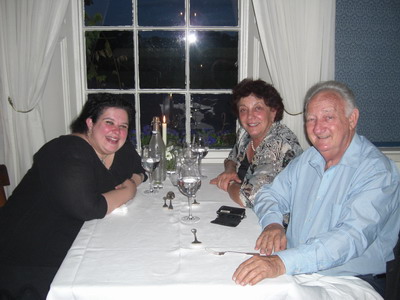
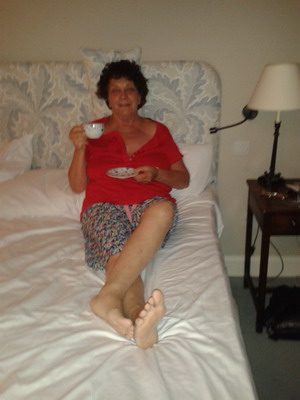
Doreen's favourite tea is Irish Breakfast Tea (it's the only tea she drinks in Israel), so drinking Irish Breakfast Tea in bed first thing in the morning in Ireland was celebration number 2.
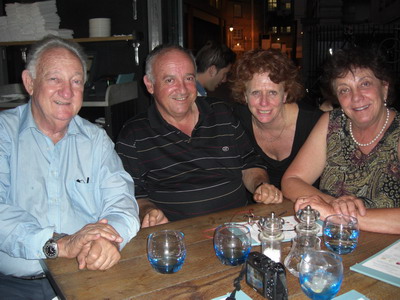
The third celebration was on the evening of the 11th at the "Fish Works" in London where we enjoyed a delicious dinner with Charles and Sheenagh Levy.
Column 20: May 2014 -A visit to the West Bank
A search for a guide who could take an
overseas visitor to Bethlehem and the West Bank lead me to the
organizations,
both Israeli and Palestinian, that lead such tours. Of course people
from
overseas are free to travel throughout the West Bank; Jewish Israelis
are not
allowed into Area A (total Palestinian control) but can visit Areas B
(Palestinian municipal control and Israeli security) and C (total
Israeli
control).
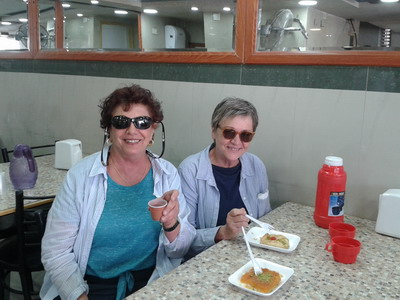 Although the overseas visitor did not go, I
went. So, one day my friend Ruthie and I joined a tour of the central
Shomron
in the West Bank, run by Machsomwatch (www.machsomwatch.org), called Daily Life in the West Bank.
Although the overseas visitor did not go, I
went. So, one day my friend Ruthie and I joined a tour of the central
Shomron
in the West Bank, run by Machsomwatch (www.machsomwatch.org), called Daily Life in the West Bank.
We drove to view the enclave of the Israeli
Alfei Menashe settlements, surrounded
by the infamous Wall
that makes them part
of Israel proper.
The Palestinian town Qalqiliya is cut
off
from its hinterland by the continuation of the same wall, leaving only
one
narrow exit to and from the village. Since in other places (like
Azzoun), the wall
cuts off
Palestinians from access to their agricultural land there are special
agricultural gates in the wall that at best are open for a very short
time
three times a day and at worst twice a year. Special permits are needed
even
for those who pass through the gates daily. We watched as residents of Habla - on foot, with donkey –drawn carts and
vans - waited for the yellow gate to open.
We met with local Palestinian leaders and
the wonder is that there are still Palestinians committed to peaceful
coexistence with us!
On the tour was an Arabic-speaking couple.
The woman told Ruthie that she came from Palestine, but wouldn’t
elucidate.
Later we learnt that the couple lived in Toronto. After the tour they
took the
train to Haifa - Palestine! Earlier
during a presentation of the conflict the woman said that in 1967 200,000 Palestinians were
transferred
from their
homes. When I suggested that in such an emotionally charged subject, it
was
very important to use the correct terminology and that people were not
transferred in 1967 (as opposed to 1948 and 1949), she
said “So what do you call people who are not allowed to return to their
land?”
My reply of “refugees” brought her angry comment of: “Don’t you try and
lecture
me.”
I felt this was a missed opportunity to
discuss
such a painful subject
and a timely reminder that there are other, very different narratives,
and no
matter how liberal we think we are, to others we are just part of the
repressive institution of occupation.
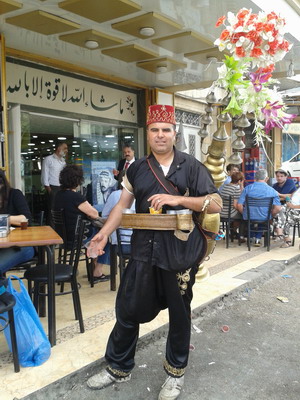 At lunch time we stopped at
Huwara for incredibly
cheap falafel and
kenafe and coffee. As we walked around people either ignored us or were
friendly. A man selling carob juice from a picturesque container gave
an eerie
feeling of normalcy to the setting.
At lunch time we stopped at
Huwara for incredibly
cheap falafel and
kenafe and coffee. As we walked around people either ignored us or were
friendly. A man selling carob juice from a picturesque container gave
an eerie
feeling of normalcy to the setting.
There were times during the day when we
felt
uneasy as we saw how we
embitter the lives of Palestinians living in the West Bank, and yet it
was
peaceful and often pleasant.
It is not always so. We are told that about
30,000
Palestinians have
permits to work in Israel. In the pre-dawn hour Palestinians rush to
cross the
checkpoint after sometimes waiting for hours. I am a volunteer with
Road to
Recovery, an NGO that takes sick West Bank Palestinians, mainly
children, to
Israeli hospitals for treatment. (see a previous
column). The Palestinian Authority pays for the
treatment but they have to get to the hospitals on their own account.
That is
where we step in, have to find them among the hundreds of workers and
then
drive them to hospitals. There are some very nice ‘terminals’ but the
conditions
at the checkpoints to where I am sent are invariably appalling and the
lack of
sanitary services unacceptable.
www.breakingthesilence.org.il does tours of the Hebron
area
IPCRI, Israeli Palestinian Creative
Regional
Initiatives does tours of
Bethlehem, Jericho and Ramallah, cities which are usually closed off to
Jewish
Israelis.
Column
19 (April 2014) - Read about our trip to Vietnam
Column
18 (March 2014) - A dive in the shipwreck "Yongala"
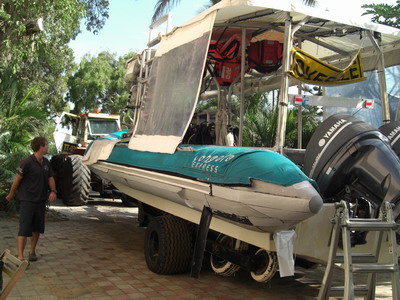
Less than 48 hours after
landing in Townsville and after a sleepless night, Moran, Mikhal and I
set off
to dive the Yongala wreck. The dive club at Alva Beach looked Bahamian
– slightly run
down
and disorganized, the promised breakfast wasn't ready and we saw people
patching up the rigid plastic boat with superglue and then with super
adhesive
bands. Not such a good impression…….
But the dive introduction
was good and the instructor was very professional. The boat, finally
patched
was released into the water and at fast speed we sailed 40 minutes into
the
ocean to the wreck.
Preparation for a dive is always somewhat nerve wracking; we had to back somersault into the water and I was worried I would get giddy. We were told that the current was quite strong and to make sure that we immediately grab hold of the rope otherwise we would find ourselves in New Zealand! When we all were in the water and feeling comfortable, we pulled ourselves down the rope to the Yongala wreck. The steamboat was wrecked in 1911 during a cyclone and all 121 people, passengers and crew drowned. It lies at a depth of 30 meters on a sandbank, but over the years has become a base for the prolific growth of hard and soft corals and sponges. These in turn have attracted and provided shelter to the fish.
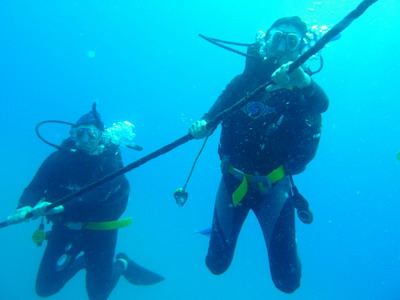
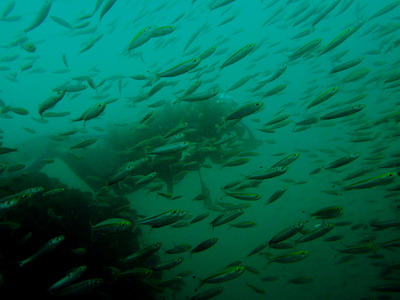
Although the visibility
was poor because of the recent rain we were amazed by the amount of
fish around
us. Aza, our guide told us that the reason the fish were so close was
that they
too couldn't see and so came up very close to see what we were. There
were
thousands of small fish on and in the hull with extremely large
groupers, file
fish, and parrot fish hovering or feeding on the corals.
A little
further out
we saw eagle spotted rays pass as shadows in the murky waters, a bull
shark and
sea snakes writhing on the sand floor. But for me, most amazing were
the bat
fish. They swam close to us in pairs but we also saw a shoal in the
hull
waiting to be cleaned
After 44 minutes at 29 meters
we hauled ourselves up the rope to the boat. As we decompressed we
watched shoals
of trevally and jack swim around and around us. Climbing
back on to the boat with full gear
was no mean achievement. Where was Aviv to do everything for me?
The time on the boat was
spent with Mikhal and me feeling seasick while the others tucked into
the fruit,
cakes and wraps. Aza told us about the history of the wreck. We watched as sea snakes rose to the surface
to breath and dive back to the depths, turtles break the water to
breath and
birds, frigates and brown boobies feed on small fish near the surface.
Our second dive was only
to 20 meters so we were swimming above the wreck. Towards the end we
saw a huge
shoal of bat fish, many of them totally white except for their brown
tails cluster
around the hull of the ship. That was so amazing that it was enough and
after
33 minutes we rose up the rope back to the boat.
When we neared the
shores, sand banks prevented the boat from beaching so we had to wade
through
the
water. A pleasant end to a great day!
Click here for more about the SS Yongala and dive information, and don't miss the video showing the amazing fish found in and around the wreck.
GO TO TOP OF PAGE
Column 17
(October 2013) -
some sites, family and friends in Johannesburg
On previous trips to Johannesburg we have spent
our time visiting family and friends and bought peppermint crisps and
biltong; nothing else to do in Jhb. From there we have gone on to
Kruger, Durban and Capetown where there was plenty to do. This
trip
was different. It was our final last trip to South Africa and while
Eitan gave a course to South African tournament bridge directors, I
played the tourist.
Sheenagh, cousin Charles Levy's wife, took me to
the Mandela exhibition at the Apartheid Museum. It
was a most impressive exhibit, covering Mandela's life, his
achievements, successes and failures. The exhibit showed how he was a
born leader, but that he had to learn to become who he was, an
incredible
statesman and world leader. Surprisingly, much of this development took
place in prison on Robben Island.
We then went to Constitution Hill, built on the Old Fort, where
Africans were detained mainly because of the hated pass laws. The new
building incoporates the bricks from the holding cells and is filled
with art works. The statue below is at the entrance, depicting the
enslavment of non-whites under apartheid. The wooden doors behind
have
the values enshrined in the Constitution carved in 11 languages
including braille on the massive entrance doors, by artisits from KwQua
Zulu.
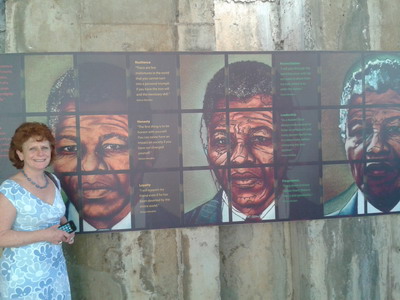
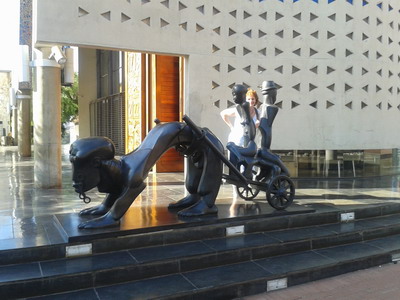
Here
Sheenagh Levy stands in front of a wall with paintings of Mandela
at
different stages of his life and enumerating the facets of his
leadership.
.
Visitng relatives is a very important part of our visit to South
Africa. Here I am pictured with cousin Marsha and husband Solly
Krengel. ( Nochimovitz/Nickel family
tree) at their home in Waverley. Renewing ties and catching up on
family news fills a need in me.
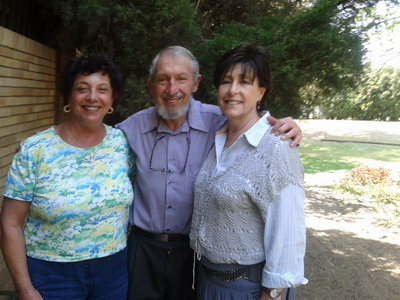
Although Eitan and I left South Africa in the mid
60's,
schoolhood
friends are still very important. Eleanor Pines schlepped me
around
shopping and also showed me around. Yvonne Heitner joined us one
day
and first we went to the very worthwhile Everard Read Gallery. Here we
are in front of a painting of Soweto by Vusi Khumalo. The interesting
thing about the painting is that when we think of Soweto we think of
the
poverty and miserable living conditions. The colours here are bright
and optimistic, even though revealing the roofs kept in place by large
stones,
but the colours and scene reveal vitality and a place people call home.
We all loved it.
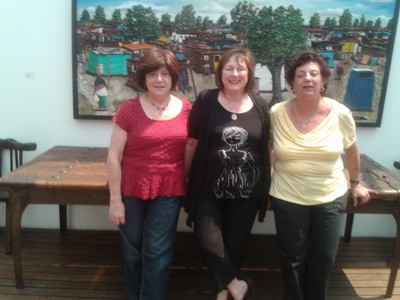
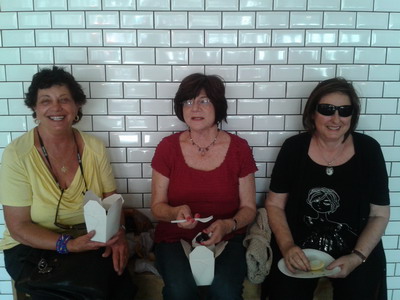
For
many years
downtown Johannesburg was thought not safe and although many parts are
totally black there are pockets of restoration and rebuilding that have
people of all color mingling happily together. In Bree Street we went
to the Neighborhood Market.The variety of food at the stalls was
impressive. We passed up the different beers, wines and champagne and
instead had fruit smoothies at a stall run by a mutual friend of
Eleanor and
Yvonne. Although we thought the market was absolutely packed we
were
told that it wasn't too bad, mainly because, I think, that the Chief
Rabbi of Johannesburg had called upon all Jews, especially the
non-observant ones to keep the Shabbat. The response was overwhelming
and
in one area more than 2000 challot were prepared in the street!
We
were
not part of that; even so the only place we found to sit in the market
was on a bench
at the entrance to the wash stands and toilets!
The Tarazza family: Giorgio, Vanessa (nee Glasser), Micaela and Cinzia (with friend Francois). (Gordon/Glasser family tree). Vanessa is my first cousin and although we had lost contact for many years, we now keep up steady contact and were pleased to meet up again. Cinzia, now studying to be a teacher kept us informed about her activites as a cheerleader at school and we are delighted that she has become a beautiful young lady like her mother.
We left for Mocambique knowing that there was still much to be seen in Johannesburg and wondering if we could could change "final last tour" to something else.
For more on our SA trip, click here.
Column 16 (September 2013 - Some musings on Sukkot.
The
Sukkot holidays this year
have turned into a long extended holiday with children off school from
Yom
Kippur until the end of Sukkot,
and this after the long summer holiday.
After
spending Yom Kippur
with Aviv and family in Eilat we brought our three Eilat grandchildren
back
home with us. We have many friends who
are dedicated grandparents and devote at least a day a week to looking
after
their grandchildren. Since our children
are not nearby, our style is different, and we get to look after them
for an
extended period, day and night. It is a
chance to broaden their horizons and introduce them to things that are
not
available in Eilat. When we lived in
Eilat I never thought of Eilat as lacking in anything, but today, to
me, life
there does seem limited.
Looking
after three children
is a major undertaking and I continually wonder how we managed to bring
up
three children without TV, without internet or smartphones! And work,
travel
and have a social life in addition.It
is true that our children spent a lot of time amusing themselves,
riding bikes,
playing on the street with the neighborhood children and reading. Today
children have to be constantly
monitored and managed!
Our
days with the Eilat
grandchildren had a definite structure. Wake up, always too early for
us, and
then tea on the verandah to discuss the day's plans. Bake muffins or
make pancakes
if I have the energy. Free time for
games, reading or TV. Then make sandwiches for later in the day (Saba
Eitan
makes the best sandwiches ever!) A pre-outing snack and then off we go
to the
day's planned outing (see photos).
Eat
sandwiches and then the afternoon program.
After
spending three days
with us, the children went to Vered and family. We joined them for Erev Sukkot in their beautifully
decorated
sukkah and
enjoyed the traditional blessings and especially the waving of the four
species. Levticus 23:40; " .....You shall take the
fruit of the citrus
tree, branches of palm trees, boughs of myrtle trees and the willows of
the brook, and you shall rejoice before the Lord for seven days."
Each of the
four species has
a symbolism:
- The etrog has both taste and smell and is meant to symbolism a person who has both learning and does good deeds.
- The palm branch has taste but no smell, symbolizing one who has learning but ignores doing good deeds.
- The myrtle has no taste but does have a fragrance, symbolizing one who has no learning but does good deeds.
- Lastly the willow has neither taste nor smell, symbolizing some-one who has no learning and does no good deeds.
Together
they make up the
people of Israel and all are an important part of the Four Species.
I
once heard
that during Yom
Kippur, when people repent (sometimes only momentarily) of the
bad
things they
did, they then feel cleansed, proud and very full of themselves. The
very next
holiday sends us to the sukkah,
a hut, to simplicity, to cramped quarters and
the
vagaries of the weather. Puts a little perspective on things. A nice
idea.
Column 15 (July 2013) - My impressions and thoughts on a trip to Poland
I
have recently returned from a journey to Poland with Yad VaShem. You
can read what I have written on this emotional journey by clicking here. Everybody knows that London is for
shopping,
theatre and
good restaurants, but here are a few ideas for other things to do: We learnt about the differences between
graffiti,
tagging
and street art (in Israel it is still all lumped under graffiti) and
were
amazed that artists would willingly create something knowing that it
would be
defaced or drawn over by some-one else in a few months or even weeks. You can walk down Brick Lane, unaware that
hidden from sight a few meters away was some really interesting street
art. One evening Eitan and I went for a walk
down Brick
Lane.
Curry, tandoori and balti restaurants line the street and no wonder it
is advertised
as the curry capital of the world. Ignoring all the touts we went to a
restaurant we had chosen (with a discount if you book over the
internet). It
was packed and the food was good, but we were glad that, to our taste,
our
little curry restaurant in the West End, tucked between all the Chinese
restaurants remained our favorite. We
went
to visit the Eden Project (www.edenproject.com).
We drove along country lanes
lined with tall hedgerows. These were so narrow that we had to stop to
maneuver
around cars coming from the opposite direction. When the view opened up
we were
treated to expansive views of rolling countryside dotted with stone
farmhouses,
green fields with sheep and cattle and yellow fields of rape seed. It
was such
demanding driving that we were sure we would be about the only people
at the Eden
Project. The few cars in the parking lot confirmed this, until we later
saw
that we were the last of about 7 huge parking lots, all already full.
The place was
packed! There obviously was an easier way to get there. The
Eden
Project has turned a disused clay quarry, an ugly multi-terraced scar,
into a
magnificent green landscape with three Biomes, one outdoor and two
under cover:
a recreation of a rainforest (the
largest indoor rainforest in the world) and
the other of Mediterranean climes. The
emphasis is on renewal and bringing awareness to how we use, or misuse
our
planets renewal resources. On
the way back we drove through the Dartmoor Moors, recalling the setting
of The Hounds
of the Baskervilles and Sherlock Holmes. It is a
bleak expanse of peat and bogs with granite torrs
jutting out of the grass. It must be a bitter place when the cold wind
howls
across the open fields. All about there
were ponies grazing; they are wild but accustomed to humans and so
don't run
away. All the female ponies had either just given birth or about to. It
was
delightful. We
continued to the huge Dartmoor Prison. It
was already late in the afternoon and the prison looked closed, but
when we saw
two women exit a door, Louise and I opened it and began to enter when a
guard,
behind an inner metal gate stopped us. We only wanted to visit, we
politely
explained. He was adamant that we couldn’t, even if we committed a
felony as
this was a working prison for men and suggested we visit the prison
museum
instead!
In the evening on the way back we went
to a nearby pub, the Lymington Arms, for dinner - to find it was a
gourmet restaurant.
The chef had worked at a fancy hotel in Barbados. The night before we
had eaten
an excellent curry in Chumleigh. Jenny That
night we ate rhubarb cut from the garden, leaving the other veggies for
the
gardener and the rabbits. Having decided to spend Pesach with Moran
and Mikhal and
children, we set off to the other side of the world. Our trip
encompassed Hong
Kong, Melbourne, where we had two seders
- but neither with the Segolis – Tasmania
where we did day walks and had a third seder with
the Segolis, Bangkok and Myanmar. I hope the vicarious reading brings to life
a
little of
the interest and joy that we had on our trip.
Herodion is an artificial mountain, today resembling a
volcano but described by Josephus in “The Jewish Wars” as resembling a
woman’s
breast because 2,000 years ago a tower rose above the walls.
In 40BCE the Parthians, the greatest
competitors
of the
Romans had placed their candidate, Mattatiyahu Antigonus, as Hasmonean king of Jerusalem. The Romans backed Herod.
The Parthians and supporters of the Maccabee-Hasmonean bloodline chased
Herod
out of Jerusalem. He left with his mother Cypros, Mariamne his
Hasmonean princess-fiancée, other family members and soldiers.
He won a major battle against the
Jews near Herodion. In the chase his mother’s carriage overturned and
fearful
that she would die, Herod became suicidal. She lived and they all left
for
Massada (another story, another time). After gaining Roman backing he returns to
Judea
and with
Roman soldiers conquers his kingdom, becoming sole ruler in 37 BCE. In 23 BCE he begins building Herodion. Many
towns
and
monuments are named after his patrons , like the Antonia in Jerusalem
after
Mark Anthony and Caesarea Maritima by the Mediterranean after Augustus
Caesar.
Desert fortresses are named after family members like Cypros near
Jericho named
after his dear mother. Herodion is the only complex that bears his
name. The
striking mountain that can be seen from Jerusalem and nearby Bethlehem
is a
monument to his victory over the last Hasmonean prince and celebrates
his
building prowess, his achievements and power. Herodion acted as an administrative center
but at
the bottom
of the hill Herod first built a large palace. His friends followed suit
and built
their houses there too. On the side of the mountain he built an
intimate
theatre of only 200-300 seats and above it a reception hall with
fascinating
frescoes that look like pictures hanging on a wall, with chain and
nail, but
also framed with shutters. The frescoes are unique in Israel with
paintings of
animals and people. Herod was of Idumean origin. During the period of
the
Hasmonean Kings Johanan Hyrcanus conquered the Idumeans and told them
to either
leave town or convert. The Idumeans as a people converted. The picture is of a scale model of what
archaeologists think
Herod's mausoleum looked like. His sarcophagus would have been placed
on the second storey Ehud Nezer is the archaeologist who dug
extensively at
Herodion. Only after spending 37 years looking for Herod’s tomb at the
bottom
of the mountain, did he notice an irregularity in the mountain side,
discovering the broken tomb in 2007. The irony, (perhaps Herod’s curse?) was that in 2010, while guiding at Herodion,
Ehud Nezer sat on a wall that collapsed and he fell to his death. Did I forget to mention that Herodion,
situated in
the
Judean desert has no natural water source?
That wasn’t a problem for Herod who built an aqueduct bringing
water
from the Artas springs some 8 km away. The water was collected in a
large
square pool surrounded by columns, which was used for boating and also
served as a water reservoir with gardens and trees around it - a
country club for him and his friends.. Intensely aware of the importance of water,
Herod
had 3
large water reservoirs carved out inside the mountain. One was
used
to
collect rainwater from the floor of his fortress palace and the others
were
filled by bringing water from the pool/reservoir into the mountain
reservoirs. Herodion was used was a hideout both by
Zealots
during the
Great Revolt around the time of the destruction of Temple II and by the
rebels
of the Bar Kochva revolt. They carved tunnels,
joining
the cisterns so they could make surprise attacks against the hated
Romans. It
is believed that the Bar Kochva rebels smashed Herod's tomb,
symbolizing their
hatred for everything Roman and Roman influenced. Josephus vividly describes the death of
Herod in
Jericho in 4BCE and
how he was laid on a golden bier and covered with the royal purple,
scepter and crown. With great
pomp he was born by soldiers and accompanied by family, servants and
slaves to
Herodion where his body was placed in the sarcophagus inside the
mausoleum. Our
first stop was at Nahal Ayit. As
we got out of the car we were surprised by the wind and bitter cold –
back on
the coastal plain it had been a windless sunny day. Luckily we were
prepared.
Nahal Ayit is a perennial stream but its flow was much stronger and we
could
see, well above its present flow, branches caught in the bushes,
evidence of
the height of its flood. The basalt
columns (see Picture of the Week) were formed, like most of the Golan,
by ancient
volcanos, now extinct. As the lava cooled it cracked forming these
fascinating
columns that look as if they were hand crafted. We
continued to Gamla and were
greeted by vultures circling above Nahal Gamla. Assured that the walk
to the
Gamla falls was straight and not muddy, we bundled up again and set
out. It
wasn’t muddy – in places – and we had to squelch our way over stones
and clumps
of grass many times. The picture of
Yael, Caroline and I expresses our delight in the long walk and we felt
that
the wind had blown away the cobwebs from our brains.
Gamla Falls, at 51 meters, are the highest in
Israel (see picture on left). On
the
way back we looked at the enclosure on the edge of
the cliff where young vultures are kept for a few years before their
release to
enable them to acclimatize and learn their surrounding before they are
released. There are about 5 pairs of
vultures that are preparing to nest at the moment. The vultures are
severely
endangered by increased human activity in the area, farmers putting out
poisoned meat to kill wolves, ecological changes, and just less
available
food. The cliffs are under video
surveillance
and after a vulture has laid an egg, someone from the Nature
Preservation
Society rappels down the cliff to take the egg which is kept until it
is
hatched. This is because the survival rate of the eggs and young is
very low;
they also hope that it will cause another egg to be laid that year. It is these young vultures, before their
released that we saw in a cage on the cliff. Through
midrashim (rabbinic
commentaries) we know that there were more than 20 synagogues on the
Golan
during Talmudic times. My favorite story is about Elazar HaKapar.
During
emergency archaeological surveys after 1967, a basalt lintel was
discovered on
one of the houses in Dabura with the Hebrew inscription, “This is the beit
midrash of Rabbi Elazar HaKapar, the Caper Maker.” This gave new
meaning to
a discussion in the Talmud about “dangling on Shabbat.” During Talmudic
times
(equivalent to the Byzantine period) people lived by Jewish law. Since
they were
not allowed “to dangle” on Shabbat, meaning they couldn’t carry things,
the
question arose when could one wear new shoes on Shabbat. Even today
many of us
know that a perfectly comfortable pairs of shoes in the shoe store
turns into a
torture instrument once outside and need to be taken off immediately.
So back
then to prevent dangling they would have to be walked a distance equal
from
Katzrin to the bet midrash of Elazar the Kapar, about 4
kilometers,
before being worn on Shabbat! Although the story is not connected to
Umm al
Kanatir, it is too good a story not be recounted here! At
Umm al Kanatir we walked down
basalt steps and entered the synagogue. Many of the stones are numbered
as the
floor was removed to see what was underneath, and then replaced, stone
by
stone. But the most striking thing about the synagogue is the two meter
high
arched bimah (altar), in place facing Jerusalem, with rosettes
and other
decorations carved into the hard basalt stone, including
two seven branched menorahs with three-legged
bases, incense burners and lulavim (palm fronds) (for Succot). We
then walked over to the remains
of three arches with pools where sparkling water still gushes forth. In
Talmudic times the village was known for its flax production sold both
to the
rich and the poor. The running water was necessary for the cleaning and
bleaching of the flax After
a walk back up to the car we
were more than ready for lunch. We drove down to the shores of the
Kinneret and
went to Marinda restaurant, excellent for steaks, to celebrate an
exhilarating
day. Volunteering
is a very important value in my life. My erratic lifestyle usually
precludes me
from volunteering because sometime-volunteers are usually not easily
incorporated into organizations. “Road to Recovery” is ideal, as one
can sign up
whenever one has free time. "Road
to Recovery" is a volunteer organization that transports sick
Palestinians
from the West Bank to Israeli hospitals for treatment that is not
available
within the I
usually transport children and their parents from a West Bank
checkpoint to a
hospital in
Column 14 (July 2013) : A yachting trip to Corsica.
Click here to read
what I wrote and
see some pictures of our yachting trip to Corsica and Elba.
Column 13 (June
2013): Other things to do in London
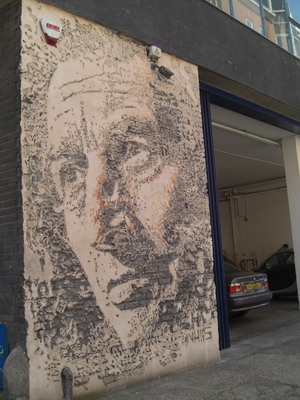
Try and go when the weather is nice, it does make a
differenceJ
Warned that it was cold and rainy we were totally unprepared for the
cloudless
blue skies and fair temperatures.
www.alternativeldn.com
www.livingjewishhistory.com/tours
Eitan: For a different aspect of street art, read about the wall murals we
saw
in Tasmania.
Column 12 (May
2013) : A few days in Devon
Going
to London with Louise made this trip a little different and delightful.
We
started by staying at a farm in Devon. No humble stone cottage, this
farmhouse
was spacious and well equipped, more like a manor with beautifully
tended
gardens. The weather was perfect – that magical combination of blue
cloudless skies
and crisp temperatures that makes one happy to be alive.
This picture was taken shortly after the deer
had crossed the lawn heading for cover under the trees and the rabbits
had
hopped off to have their dinner at the farm's vegetable garden. Just as
trying
to catch a rat with cheese is hopeless as they much prefer sausage,
these
rabbits scorned carrots and headed straight for the asparagus and leeks!
This
huge monster, called WEEEman (Waste Electrical and Electronic
Equipment) is made up of the electrical and electronic waste a person
discards in his lifetime. (over 3 tons).
We then drove one and a half hours in the
opposite direction to the North Devon coast and stopped at Ilfracombe.
It is a
picturesque coastal town with rows of tall Victorian houses. There is a
big
difference in the tides and we watched fascinated at attempts to
extricate a
car from the wet sands. After the first failed attempt and watching the
rising
tide, Anthony suggested the best thing was for the man to quickly
change his
insurance from that of a car to that of a submarine.
The coast was dramatic with stone torrs
rising out of the sea. We had fish and
chips with malt vinegar for lunch, again. Perhaps surprising on my
part, as previously
in London at Paddington station while eating fish and chips a fish bone
got
stuck in the back of my tongue and it was quite an effort to pull it
out.
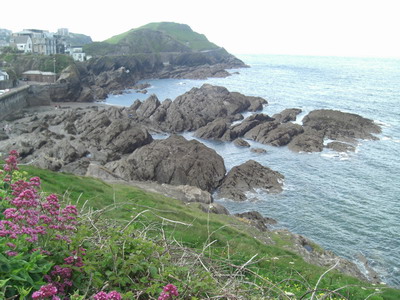
Column 11 (May
2013)
Keeping
up
contact with grandchildren across the oceans with very different time
frames is
problematic. To find a time suitable to talk to Maayan and Lotem when
they are
not watching a DVD, not too tired to talk or not busy with homework,
can be
challenging! When I mentioned that I
am
thinking of writing another cookbook Maayan and Lotem offered to test
the
recipes. In the meantime they tried the cheesecake from my old
cookbook. Lotem wrote; " I would give 154 points and even when
we make mistakes, it's still delicious! Love Lotem. “
A
great way to keep up contact!
Click here to see the recipe, and here to see the Segoli children
preparing the recipe.
Column 10
(March/April 2013) Visits to Australia and Myanmar
I have written accounts of our trip with pictures.
Click for links to : Hong Kong and
Melbourne Tasmania
Myanmar
Bangkok
(Thanks to Susan Bell for the pictures)
Susan Bell, Louise Kessel,
Louise Braverman, Ruthie Erez, Ofra Tene, Doreen, Yael Paperna and
Caroline Livneh
Herod never denied his Jewishness, but was a lover
and
fawner after everything Roman. He changed the geography of his kingdom,
building temples and towns for pagans. By building a port at Caesarea
Maritima
he opened the land to Roman and Greek influences. He introduced the
concept of
leisure time to the wealthy, building bath houses, theatres and
hippodromes. He
imported food and wine from Italy and Spain. We may think of him today
as a precursor of a secular Jew. We have no statue of his likeness, no
idea
what he looked like. .
.
At some stage Herod decided to turn Herodion into his burial
place. He builds a belt of stone around
the mountain, literally shaves off a nearby hill and packs Herodion
with sand
and stones up to the round walls, covering everything, including the
theatre
and frescoes, leaving only 200 ‘marble’ steps that lead to the mountain
palace
through a series of stone arches. He changed the shape of the mountain. On top of this, next to the steps he builds
his mausoleum. Inside are a number of urns and sarcophagi, one of
which, carefully
decorated from pink sandstone, and smashed to bits is identified
as Herod’s
tomb.
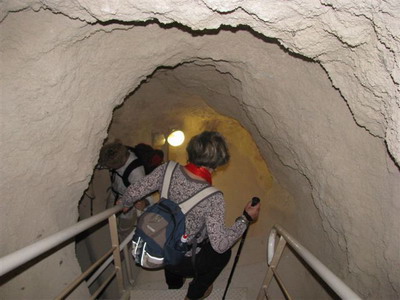
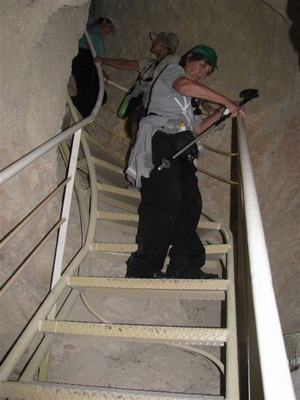 The Louises negotiate the steep
steps down to
the cisterns inside the mountain.
The Louises negotiate the steep
steps down to
the cisterns inside the mountain.
Column 8 (January
2013 A trip to the Golan)
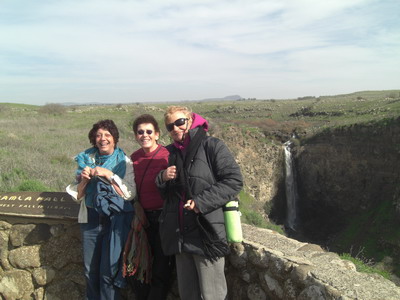
Like everyone else in Israel, we
forgot about elections, wars and Iran for a week as Israel was
lashed by extremely heavy rains and wind. We listened to the news and
noted
flooded streets and were enthralled by reports of the continual rising
level of
the Kinneret (Sea of Gallilee). So when it all passed we
decided it
was time to go look for water. So Louise, Caroline Livneh, Yael Paperna
and I
drove to the Golan. Although we were aware that most of the water would
be
flowing in the Banias-Dan area that was also where most of the tourists
(Israeli) would be, so we chose to visit the central Golan.

Our next stop was at an ancient
synagogue under reconstruction at Umm al Kanatir, recently renamed
Rehavam’s
arches.
Column 7 (October
2012 in Townsville, Australia)
Peace at last! The kids are at school (see
picture of kids in school
uniform) and Mikhal has taken Zoe to daycare for a few hours. And
we
are back on the internet.
Townsville, like Sydney, is a large sprawling city but mainly of single
story houses. Annandale, the suburb where the Segolis live, is a quiet
neighborhood. It is a 20 minute bike
ride to the university and it takes about 30 minutes to drive to the
Strand beach area. There is a small shopping center within walking
distance. The school is also within walking distance. Although Eitan
did a huge amount of preparation - thank goodness -
there is still a lot to do and some days have been overwhelming both
for the kids and us! In Davis Moran did a lot of the housework but here
he is usually at work long before the sun rises and comes home only
after dark.
It came as a surprise how Australian Townsville is - very few
non-Australians, and even less Jews and Israelis. Maayan's teacher is
from Samoa and very nice. This is very different from Davis which was
extremely cosmopolitan with people at the university from all over the
world.
A constant delight are the different animals here.. What we know as
caged birds fly around here in flocks. The house has a pool with palms
trees around. (see picture).
Yesterday we suddenly saw over ten lorikeets (a kind of small parrot)
nibbling at the fruit of a palm tree. At sunset a few nights ago
cockatoos were flying overhead and squawking as they fought in the
neighbor's yard. At night if we are lucky we see possums walking on the
fence or in the trees. The neighbours' kids told us that once there was
a poisonous snake in
our pool. That caused a lot of excitement for the family; but me, every
time I enter the pool, especially at night, I make sure that what looks
like a stick is actually a stick! I did lift up a small frog out of the
pool yesterday. If the kids weren't there I would have done it with a
container and not my bare hands. What we don't do for grandchildren!
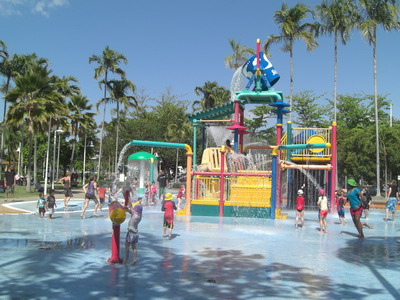 Last Sunday we went to the beach. There is a free water
park just by
the beach with free gas barbecues along the Strand. From November to
March you can't swim in the sea because of the jellyfish. All along the
beaches are containers with vinegar - an antidote to the very painful
stings.
Last Sunday we went to the beach. There is a free water
park just by
the beach with free gas barbecues along the Strand. From November to
March you can't swim in the sea because of the jellyfish. All along the
beaches are containers with vinegar - an antidote to the very painful
stings.
Through the middle of the city runs Ross River. They tell us there are
crocodiles in the river but they are very shy. Fresh water crocs are
not dangerous but beware of the saltwater crocs that come into the
rivers. There is a dam wall that is supposed to keep them out but I've
heard they come over with the flood waters in summer. A taxi driver
told me that while he was fishing, a croc took his fish. Walking along
the pathway by the river was a slightly uncomfortable feeling and I was
constantly planning escape routes in case we saw a croc! We did see
pelicans and cormorants and lots of cyclists and people either walking
or running.
It came as a surprise just how expensive things are here. Tomatoes are
between $8-$10 a kilo and if there is some special you may find some
vegetable for about $2.00. And the Australian dollar is stronger than
the US dollar! It is cheaper to hire a car for the day than to take a
taxi one way to the beach!
The weather is already warm, but later towards summer all agree that it
becomes disgustingly humid. And then the mosquitoes arrive. Glad I'll
be back in Israel by then.
Before Eitan returned to Israel we spent 2 1/2 wonderful days in
Sydney with cousins, at the opera, walking along Bondi Beach and
renewing contact with our family. Hmmm, I wonder if we can persuade
Moran and Mikhal to move to Sydney,,,,?"
While writing this I'm enjoying the quiet - even the pool pump is
quiet!
Go
to the "Road to
Recovery" site to
learn about the organization and
see a
CNN featurette
about
Yuval
Roth the founder
of the organization.
(later:
see also Doreen's Column #35)
and Column
#33
Column
5 (late
June, July 2012 in Denmark)
These last months I have had the
pleasure of meeting up with old friends – well I suppose when I look
frankly in
the mirror I can say friends who are getting old, but the intention is
of
friends from old. It started my thinking about this strange bond that
is called
friendship. I (and you as well, I'm sure) form
many intense relationships based on shared experiences at work, in
common
interest groups or when volunteering. And while the activities continue
so does
the friendship. Stop working and you might have no driving need to be
with
those people again – people who had formed the essence of your social
experience over long periods – and they cease to be friends, becoming
fond acquaintances
instead. This last month I saw Aura
(Greenberg) and Maureen (Konigsfest) in Israel, and Eleanor (Gamsy) in
London.
We have been friends since high school in Durban and through the
bonding
experience of Habonim. Maureen lives in Jerusalem and we meet quite
frequently,
but I seldom see Aura and Eleanor who live in Canada and South Africa
respectively. But the delight in our meetings is instantaneous – we
just play a
little catch up and continue with pleasure, relishing in this bond,
although we
all have other "'best friends" today. So why is the shared experience
through work over a specific time not enough to form a continuing bond?
In
London I saw Shirley Poluk – she and Gordon were at Ulpan Ben Yehuda
with
Anthony and me. Although Gordon and I had a massive argument, the
subject of
which I cannot recall now, the intensity of our ulpan experience
overcame that
and we still meet as good friends whenever possible.
From Ulpan days our other very close friends
are Hans and Lottie Reijzer from the Netherlands who, although not
related, are
part of our extended family with the added pleasure of our children
also being
close. But of course we share a passion for good food and wine… and
bridge, and
each other! And how do you form friends when
you are older and a lot of effort has to be invested to meet and bond.
My
friendship with Levia grew after Justin, her husband, died. We have
Dovvie and Ziona
and Hofit/Bet Herut in common. And of course we went together to
Florence! Last month I spent three days with
Nina and Mina in New York. How can I describe my friendship with Nina,
first in
St Thomas and later in Maryland? The intensity of our relationship had
shared
elements – we planned synagogue services together when we met there in
the
1980's; she edited my family cookbook and taught me to be ever so
careful as to
not hurt anybody's feelings. Her love of poetry and especially Yehuda
Amichai
leads her to read the English translation of his poems while I have to
read
them in Hebrew (no easy feat) and explain to her how the Hebrew version
differs
from the English translation. Nina also introduced me to Mina the Baker
from St
Thomas. That auspicious meeting cemented another enduring friendship
and
launched me on a lifelong passion to bake good bread. Pam and Pat from Sacramento CA are
among the few people who became friends through being on a tour that I
guided. It
is well known that during those intense days of touring, love (usually)
abounds
and many wish to continue the relationship, but I never do. Pam and Pat
are the
exception. Meeting them this summer just heightened the chemistry and
closeness
we felt for each other with the strong desire to meet... somewhere,
sometime. And to my friends in Israel, Ziona,
Caroline, Yael, Rachel, Dalia, and Ruthie, and the Kessel clan, and to
the
Davis family
in New
Zealand: You all form the nucleus of my meaningful relationships,
giving me in
turn strength and expansion of the spirit. And sometimes friends even
become
family, like Frankie Klaff. So in the end I don't know what
makes some people friends and others acquaintances. It seems that a
shared
meaningful experience cements such a strong bond that the relationship
is no
longer dependent on frequent communications. Perhaps it is the
expectation that
real friends will join me when they can, delight in my accomplishments
and
support me when I'm down. I expect real friends to be loyal and
consistent, to
be able to receive what I can give and in return offer their support
when
needed. I expect real friends not to use the baring of my heart against
me,
enabling me to be frank, knowing that the information will not be
passed on. I
am committed to do the same for them. Friendship, like marriage, does
not
demand equality but that there be a balance of each other's need. For some I will put myself out
even if it means great effort on my part; not meeting doesn't affect
the
intensity of the relationship and their standing in my heart. For lesser friends and
acquaintances meeting them is pleasant but not especially meaningful.
In the
end, when asked "How are you?" by lesser friends you reply "Fine."
To real friends you share what is troubling you and what is giving you
joy. So to all those whom I call my
inner friends, know that I take real joy in the successes of your
family and
worry when things don't go so well. You form the core of my well of
love and
caring and if you ever need help, call…. I hope I will be there to
answer. J And lastly to my best friend,
Anthony: thank you for always supporting me, taking pride in my
achievements
and consoling me in my failures, and always, always being there when
needed.
Column 4 (late
May 2012 in USA)
This last month was spent in the USA: first a few days with
friends in New York and the rest of the month in Davis California with
our son
Moran and his wife Mikhal and children Maayan and Lotem and newborn Zoe
Tanya
Segoli.
These
months are
revolving around babysitting. During Pesach
Vered and family shared our looking after Aviv and Limor’s three
children. At
the time of writing we are looking after Vered’s girls as she and her
husband
Aviv celebrate 21 years of marriage in New York; On May 7 I fly to
Davis
California to help Mikhal and Moran with their new baby (see picture)
and their older
children Maayan and Lotem (See Lotem’s
birthday card to Saba Eitan).
“In Nassau we often spent Friday night with Richard, Lindy and Jordan. Delightful Jordan loved to ‘make Shabbat’ and say the blessings over wine and homemade challah. Once, invited to the Davis family for Shabbat dinner, we arrived to find their house in darkness. Pinned to the door was this message:
“SORRY! Things just got too stressful…. Have taken off to Miami. Dinner’s on the doorstep” And in a plastic bag was a lump of chicken wings.

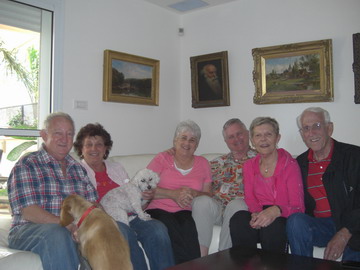
Although I
am very
friendly with my tourists I
usually don’t
become friends with them. Not so with Linda and Don Wisthuff from
Denver. No
longer arranging tours they now come privately to Israel.
Driving from Ben Gurion to our apartment in
Netanya was complicated – they got hopelessly lost, but when retrieved
we
enjoyed catching up over some refreshments.
“….. Dani (our granddaughter) lost her first tooth a few days ago. She was very excited. We worked hard to strengthen her belief in the tooth fairy. Dani wanted very much to keep the tooth. That caused quite a debate between the adults. Of course Anthony and I had opposite views. I told her that if she wrote a letter to the tooth fairy and put it under her pillow it was possible that the fairy would give money and leave her the tooth. The idea behind it was that even if you want something that appears to be impossible and you want it hard enough and are prepared to work for it (the letter) miracles can happen. Anthony on the other hand said that was unrealistic and that she should learn that wishes don't come true. Vered didn't want to leave the tooth because she thought it was disgusting. She had enough trouble with the (chicken) wishbones that Dani is collecting under her pillow (later).
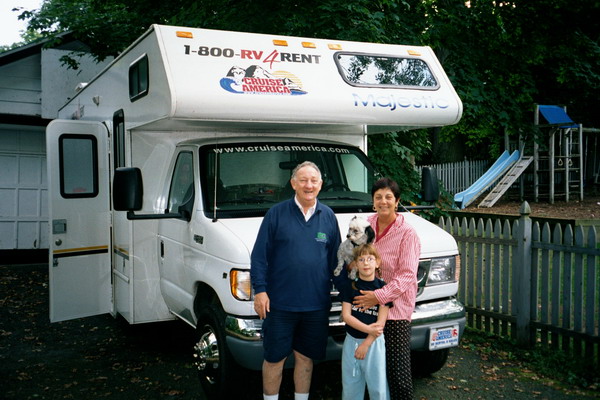

At supper, while Anthony was carving the chicken, Dani began to cry, telling us about a really frightening dream she had had. That afternoon I had read her a Dr Seuss book and it mentioned a fishbone and a wishbone. We had looked at the pictures, talked about it and she made a wish. So at chicken dinner while she was crying when Anthony carved out a wishbone, I seized it and told her it was great luck. She made a wish about ensuring good dreams, wrapped it under her pillow and slept well. When we returned to
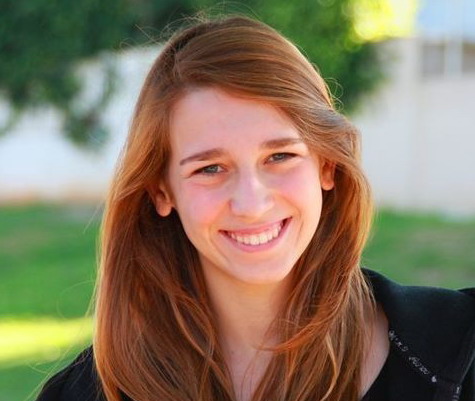 Dani today
Dani todayWe entertained many people during the month, old friends from Durban and the early days of Netanya, from Hofit and just friends.
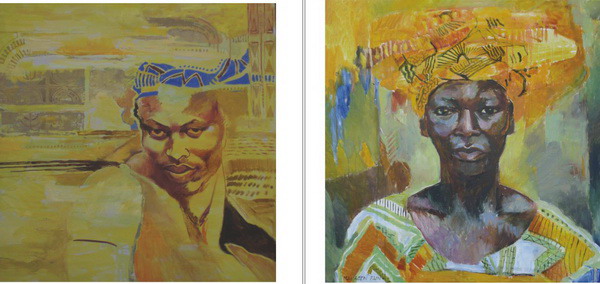
 with Nevat and Ilana Ephraty
with Nevat and Ilana EphratyGO TO TOP OF PAGE
Go to Doreen and Eitan's Home Page